

Yacht vs Catamaran: Which Boat is Right for You?
- On October 23, 2023
- No Comments
When it comes to leisure boating, two of the most popular options are yachts and catamarans. But what exactly is the difference, and which one is better suited for your needs?
In this comprehensive guide, I’ll compare the key characteristics between monohull yachts and twin-hulled catamarans.
Table of Contents
Visual comparison of catamaran and yacht designs, how they differ in handling and performance, onboard living spaces and amenities, ownership and operating costs, which boat is right for you, defining catamarans and yachts.
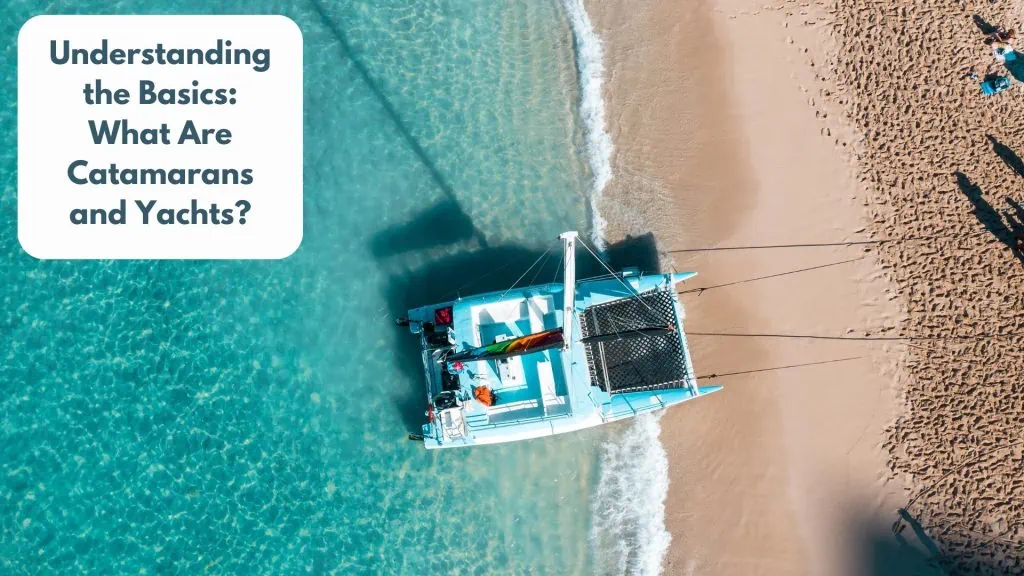
A catamaran is a type of multihull boat featuring two parallel hulls connected by a central deck. This twin-hull design provides more stability, expansive interior space, and shallow draft.
Yachts, on the other hand, have a single continuous hull and are known for their elegant aesthetics, lavish amenities, and versatility for long-range cruising.
Here’s a quick visual comparison of the general shapes and hull configurations:
| Category | Catamaran | Yacht |
|---|---|---|
| Hulls | Two parallel hulls connected by deck | Single continuous hull |
| Shape | Wider, more beamy | Sleeker, narrower |
| Stability | Very stable with minimal rolling | More susceptible to rolling motion |
| Draft | Shallow draft to get closer to shore | Deeper draft requiring deeper waters |
| Living Space | Very spacious, open floor plans | More confined spaces |
Catamarans typically range anywhere from 40 to 70 feet in length, while yachts can be as small as 30 feet or over 100 feet for superyacht models.
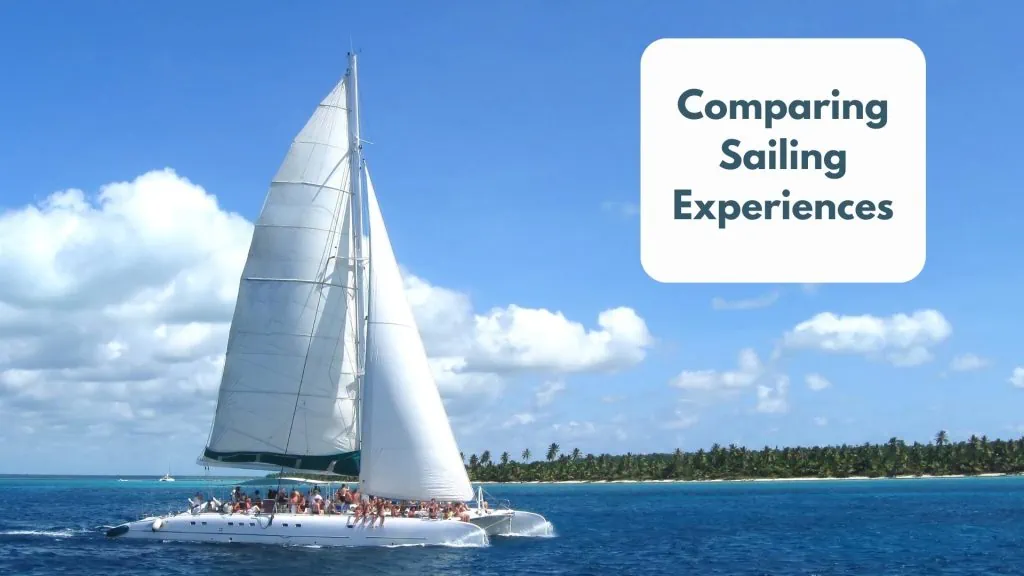
When it comes to maneuverability and sailing dynamics, there are some key distinctions between catamarans and yachts:
- Speed – Catamarans are lighter and have reduced drag, making them significantly faster than yachts. Top speeds can reach up to 25 knots.
- Stability – With their twin hulls, catamarans offer unmatched stability and minimal rocking motion in rougher seas. This also reduces seasickness.
- Maneuverability – Yachts take more skill to maneuver tight spaces, while catamarans can turn 360 degrees within their own length.
- Windward Performance – Yachts point higher into the wind and sail more efficiently upwind. Catamarans excel on reaches and downwind sailing.
So for performance-oriented sailing, monohull yachts have some advantages. But catamarans trade maneuverability for supreme stability and comfort on the water.
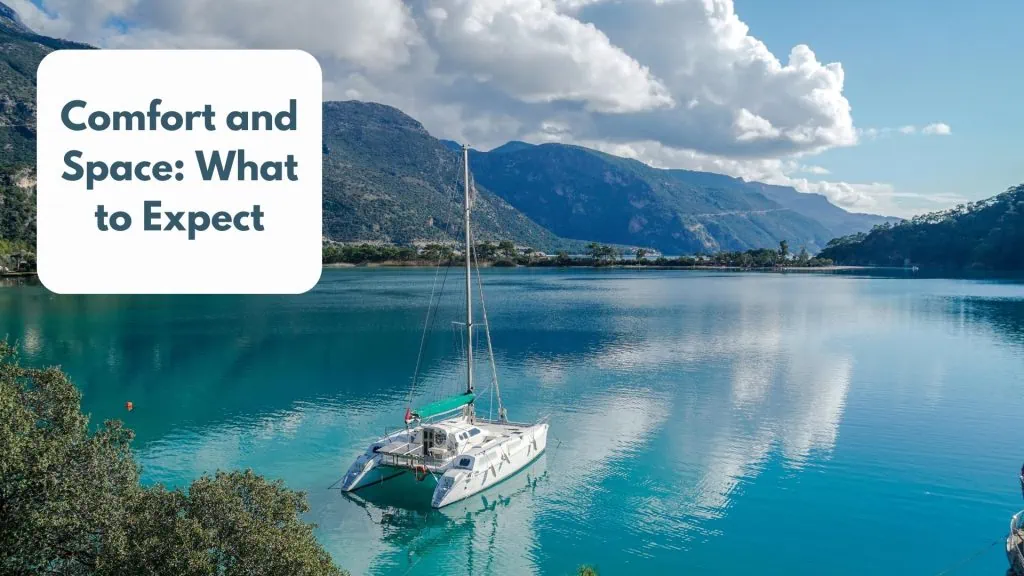
One major differentiation between these two boat types is the onboard living spaces and amenities. Some key comparisons:
- Deck Space – With their spacious bridge deck, catamarans offer ample lounging and relaxation space for large groups. Yachts have more confined deck space.
- Cabins – Catamaran cabins are typically larger and more comfortable. But yachts allow for more privacy when chartering with other couples or guests.
- Entertainment – Yachts focus more on lavish entertainment amenities like high-end sound systems, theaters, and bars. Catamarans offer more outdoor fun.
- Overall Comfort – For stability, living accommodations, and seasickness reduction, catamarans are vastly more comfortable boats.
So catamarans excel when it comes to providing generous living areas for group getaways and family vacations. But yachts are tailored more for couples charters and luxury amenities.
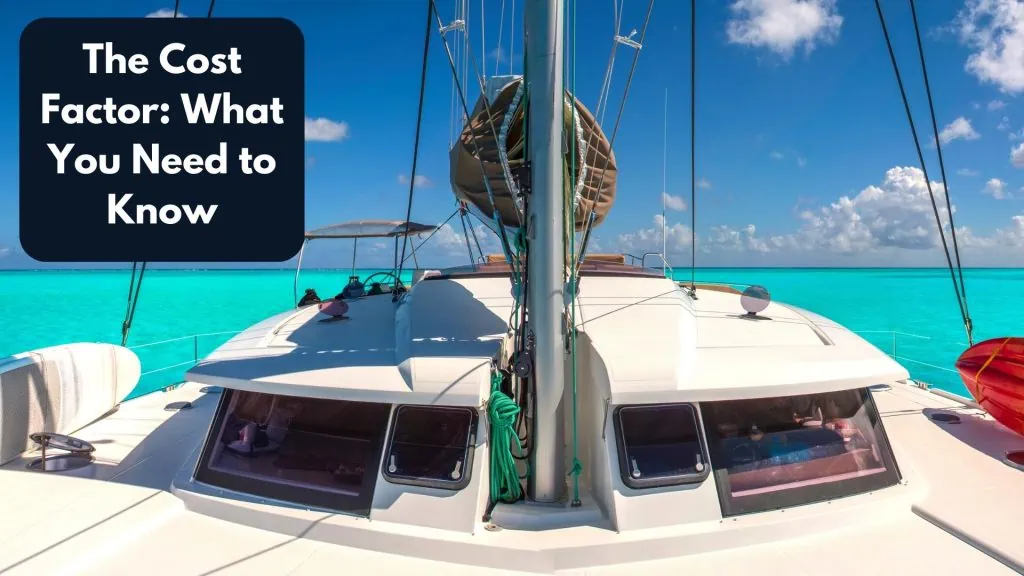
A significant factor to weigh is the overall ownership costs between catamarans and yachts:
- Purchase Price – Due to larger size and dual engines, catamarans come at a higher initial purchase cost. Yachts are more affordable for comparable lengths.
- Fuel Efficiency – With two engines to power, catamarans use almost twice as much fuel to operate. Yachts are more efficient.
- Docking and Marina Fees – Catamarans incur higher fees because they take up more dock space, especially in high-traffic areas.
- Maintenance – More complex systems and dual engines onboard catamarans equate to higher lifetime maintenance costs.
- Resale Value – Depreciation varies widely, but yachts tend to retain resale value better in the pre-owned market.
Clearly, the costs of owning and operating a catamaran are substantially higher compared to a similar-sized yacht. Being aware of these expenses will help determine the right boat for your budget.
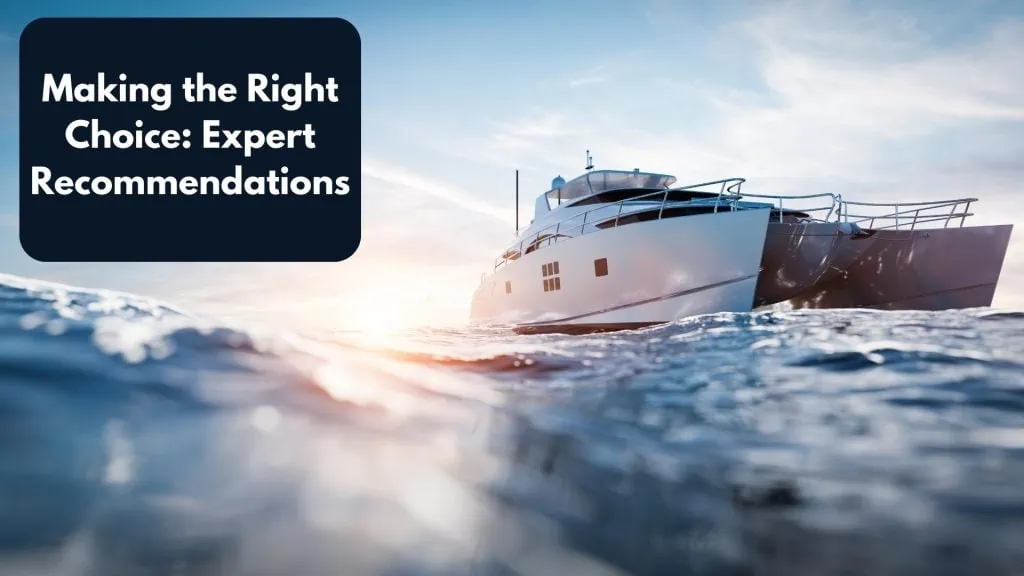
We’ve covered a lot of comparisons, so which boat type is the best choice? Here are some quick recommendations based on needs:
- For comfort, stability, and spaciousness on extended cruising trips – Catamaran
- For performance-focused sailing and nimble maneuverability – Yacht
- For luxurious amenities and entertaining small groups – Yacht
- For exhilarating speed and family-friendly features – Catamaran
- For affordable purchase and lower operating costs – Yacht
Of course, it depends on your individual priorities and boating style. Charter both for a test run to see which you enjoy more. At the end of the day, the right boat is the one that fulfills your needs and invites you to experience the magic of the open water.
Hopefully this guide has provided a helpful overview of the core differences between catamarans and yachts. Let the voyage begin!
- https://catamaranguru.com/catamaran-vs-monohull-we-changed-should-you/
- https://blog.cancunsailing.com/en/diferencia-entre-yate-y-catamaran
- https://www.mbcyachts.com/types-of-yachts-and-their-pros-and-cons/
- https://makaiyachts.com/power-catamaran-vs-monohull/
You might also be interested in reading:

The Top 3 Boat History Report Websites Reviewed
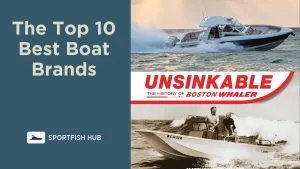
The Top 10 Best Boat Brands
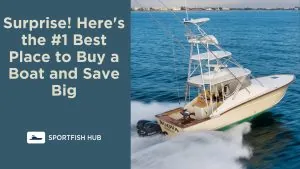
Best Place to Buy a Boat
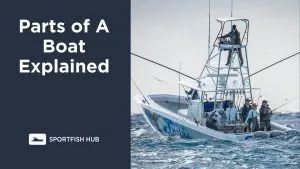
Parts of A Boat Explained
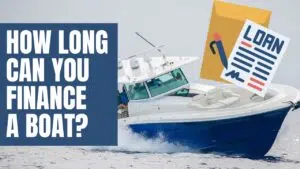
How Long Can You Finance A Boat

Steve Momot
Steve is an accomplished professional photographer and marketer who specializes in the Fishing, Yacht, and Boating industry. With a strong presence as an influencer and marketing expert in the Marine Industry, he has made a significant impact in the field. Additionally, Steve is the original creator and co-founder of Sportfishtrader. Prior to his career as a marine photographer, he gained extensive experience as a licensed boat and car dealer in South Florida.
Leave a Reply Cancel reply
Your email address will not be published. Required fields are marked *
You might also like.

Who Makes The Biggest Sport Fishing Boat?

Fishing Memes

What is Sportfishing?

Sportfish Hub was founded with a clear and unwavering mission in mind: To provide boaters and fishermen with the highest quality content, offering invaluable insights, tips, and resources.
- Terms of Service
- Privacy Policy
SOCial Media
Get in touch, © 2023 | all rights reserved.
Is a catamaran safer than a yacht?
Sailing enthusiasts often find themselves at the crossroads when choosing between a catamaran and a traditional monohull yacht. While both have their unique set of advantages, the debate on safety is often the most heated. As we set sail on this topic, let’s dive deep into the foundational differences and see which one emerges as the safer option.
Understanding the Core Design
Before jumping into the safety debate, it’s essential to grasp the fundamental designs of both vessels.
Catamarans: The Dual-Hulled Beauty
A catamaran is a watercraft that features two parallel hulls of equal size. This design not only gives catamarans a broad beam but also ensures they sit more on the water surface, rather than in it. Catamarans, due to their design, tend to have more space onboard, often making them a top pick for luxury seekers who’re looking to charter in regions like Italy. With their increasing popularity, a wide range of catamarans are available for charter .

Is A Catamaran Safer Than A Yacht 1
Yachts (Monohulls): The Traditional Elegance
On the other hand, traditional yachts or monohulls have one hull, and they sit deeper in the water, allowing them to slice through waves more effectively. This characteristic often gives them the upper hand in speed, especially when beating upwind.
Stability on Water
One of the most significant points of contention is stability. So, how do both fare in choppy waters?
Catamarans: The Stability Champions
Due to their wide beam and dual-hulled design, catamarans are less prone to heeling (tilting) than their monohull counterparts. This stability ensures that onboard activities can continue even when the sea gets a bit rough, making it a preferred choice for those who’re new to sailing or are prone to seasickness.
Yachts: Keel-Dependent Stability
Yachts rely on their deep keel for stability. While they heel more than catamarans, they are designed to right themselves up after a capsize, a feature catamarans lack. However, it’s worth noting that a modern yacht’s chances of capsizing are minimal.
Safety During Manoeuvres
How do both vessels behave when performing sailing manoeuvres?
Catamarans: A Gentle Glide
Due to their stable design, catamarans offer a smoother experience when tacking or gybing. Their dual engines (one in each hull) provide better maneuverability, especially in tight marinas. For novices, this could translate to fewer errors during critical maneuvers, enhancing safety.
Yachts: Skill-Intensive Manoeuvres
Handling a yacht requires a bit more skill, especially during maneuvers. Their deep keel and single hull mean tacking and gybing can be more intense. However, with experienced hands on deck, yachts can be maneuvered with precision.
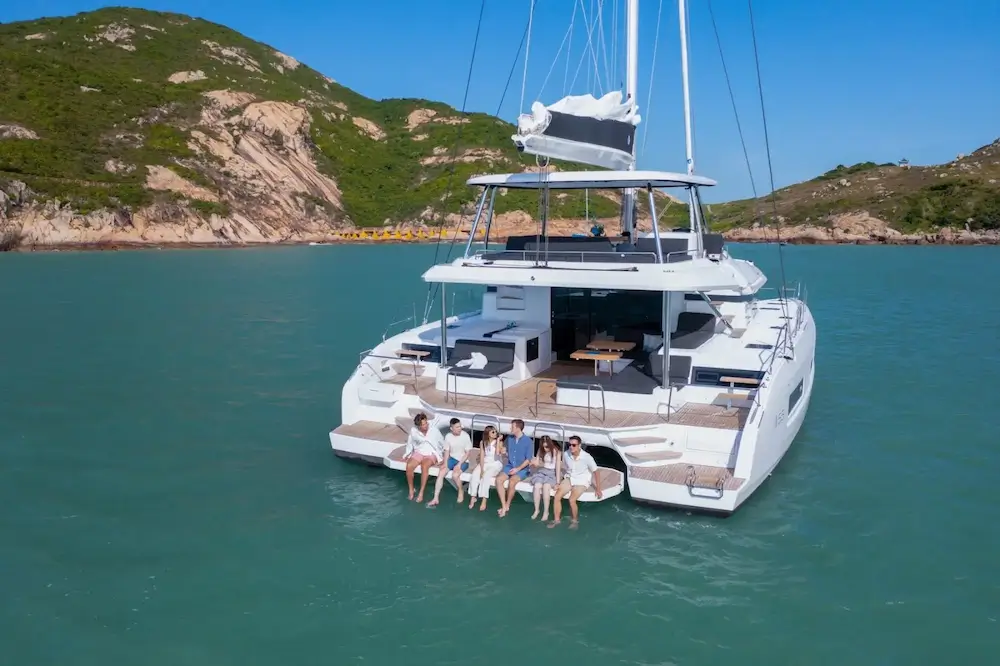
Is A Catamaran Safer Than A Yacht 2
Space and Comfort: A Safety Perspective
Space isn’t just about luxury; it’s also about safety. How do sailors benefit from the design in terms of space?
Catamarans: Spacious & Open
Catamarans are often lauded for their ample deck space. The wide beam ensures that interior spaces are expansive, making movement easier and less restrictive. Moreover, sleeping quarters in catamarans are often located away from the central area, offering more privacy. Those curious about the sleeping arrangements on a catamaran can dive into this comprehensive guide .
Yachts: Compact & Cozy
While yachts might not boast the spacious decks of catamarans, they offer a cozy and intimate setting. The interiors are more compact, which means everything is within arm’s reach, a benefit during rough seas where movement should be minimized.
Performance, Cost, and Draft: The Underlying Safety Aspects
Beyond the obvious design differences, a vessel’s performance, cost, and draft play essential roles in determining safety. Let’s explore these factors for both catamarans and yachts.
Navigating Through the Waves
When sailing in rough seas, the way a vessel interacts with waves can determine its safety.
Catamarans: Riding Over the Waves
Catamarans, with their broad beam, tend to float atop the waves rather than cutting through them. This can offer a smoother experience in light to moderate conditions. However, in stormy weather, this very trait can be a disadvantage, making the boat more susceptible to wave action.
Yachts: Cutting Through with Grace
The monohull design of yachts allows them to slice through waves. In heavy seas, yachts can offer a more predictable ride, ensuring that they can handle stormy conditions better.
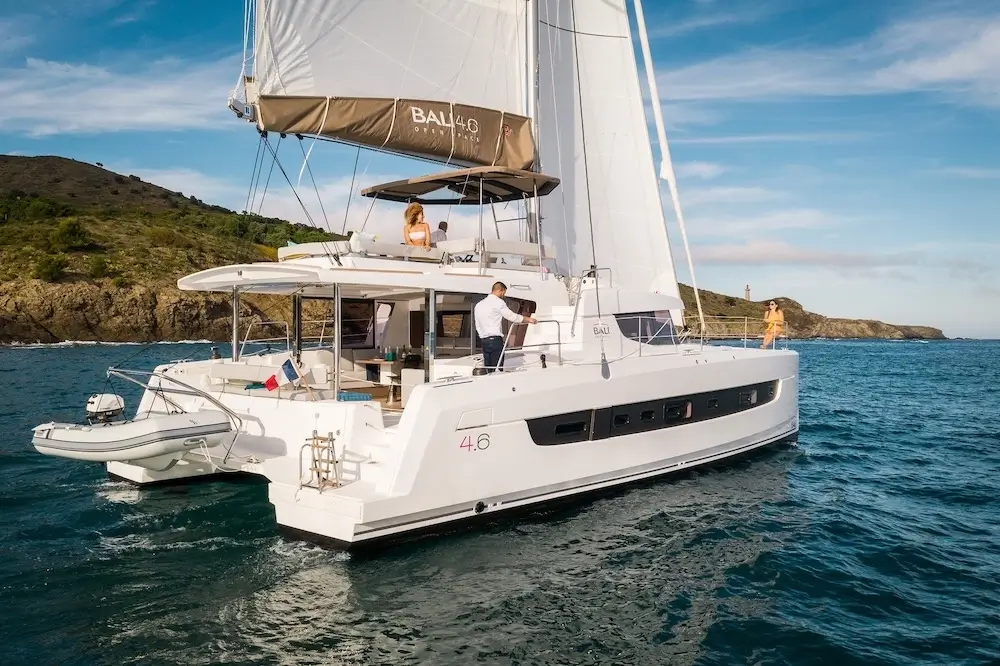
Is A Catamaran Safer Than A Yacht 3
Economic Implications: Maintenance and Cost
The safety of a vessel is directly related to its maintenance. And, often, the cost of upkeep plays a significant role in ensuring routine checks.
Catamarans: Pocket-Friendly Maintenance
Given their increasing popularity, catamarans have seen a surge in production, leading to competitive pricing for parts and maintenance. Their twin-engine setup can be advantageous. If one engine fails, the other can be used, adding an extra layer of safety during voyages.
Yachts: Steeper Costs, But Worth the Price?
Yachts, with their long-standing history, have a well-established maintenance protocol. While their upkeep might be costlier than catamarans, their robust build ensures longevity, justifying the investment.
Draft Considerations: Accessing Secluded Areas
The draft of a vessel determines how close it can get to shorelines or navigate shallow waters.
Catamarans: Shallow Draft Advantages
Catamarans have a shallow draft, which allows them to approach beaches closely and anchor in shallower waters. This trait is especially beneficial when exploring secluded areas or when seeking shelter near the shore during adverse weather.
Yachts: Deep Drafts for Deep Waters
Yachts, with their deeper drafts, are better suited for open waters. While this means they might not access shallow regions as catamarans do, their design ensures better stability in deeper, rougher seas.

Is A Catamaran Safer Than A Yacht 4
Safety Equipment and Amenities
No debate on safety is complete without considering the equipment and amenities on board.
Catamarans: A Modern Touch
Modern catamarans are equipped with the latest safety equipment. Their spacious design also allows for easy storage and access to safety gear. Additionally, amenities like multiple restrooms, vast lounging areas, and more prominent galley spaces contribute to comfort, indirectly enhancing safety by reducing fatigue.
Yachts: Classic Yet Contemporary
Yachts, being the age-old favorites, come equipped with tried and tested safety gear. Their design ensures that equipment is within arm’s reach, crucial during emergencies.
Making an Informed Choice: The Final Verdict on Safety
In the debate between catamarans and yachts, one might wonder if there’s a clear winner in terms of safety. Each vessel brings a unique set of attributes to the table. It’s essential to weigh these attributes against personal preferences, sailing conditions, and the purpose of the voyage.
The Stability Aspect Revisited
We discussed how catamarans, with their dual-hull design, offer incredible stability in calm to moderately rough seas. This stability can significantly reduce seasickness and ensure a comfortable voyage for those on board. However, in extreme weather conditions, this same stability can be a vulnerability. Yachts, on the other hand, might heel more, but their ability to right themselves offers a different kind of safety net.
Size and Space Matters
Catamarans: a roomier option.
One of the significant advantages of catamarans is their spaciousness. This feature isn’t just about luxury. A spacious deck and interiors allow for easier movement, reducing the chances of accidents on board. The ample space also ensures better ventilation, enhancing the overall experience. And, if you’re wondering where to relax during your voyage, here’s a guide on the sleeping options available on a catamaran.
Yachts: Compact but Efficient
Yachts might not offer the same amount of space as catamarans, but their design is streamlined and efficient. Every nook and corner is designed with a purpose, ensuring that sailors have everything they need within arm’s reach.
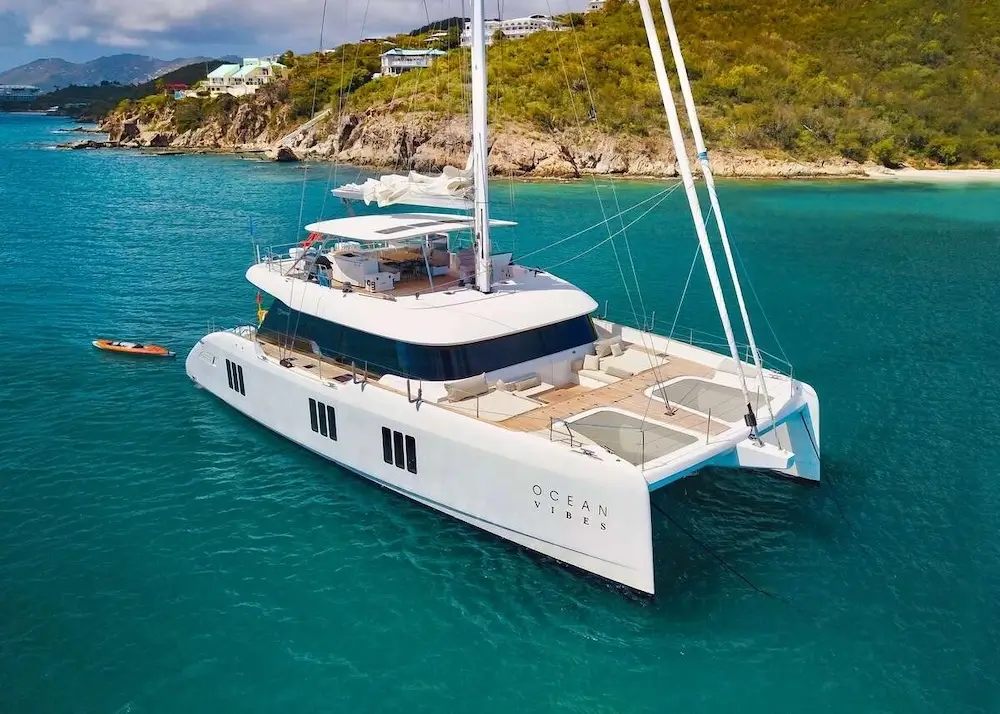
Is A Catamaran Safer Than A Yacht 5
Consider the Crew and Your Expertise
No matter the vessel, safety is often determined by the crew’s expertise and the decisions they make. A well-trained crew can handle emergencies efficiently, regardless of whether they are on a catamaran or yacht. Similarly, if you’re sailing yourself, your experience and judgment play a crucial role in ensuring safety.
What’s the Verdict?
So, is a catamaran safer than a yacht? The answer isn’t black and white. Both vessels have their advantages and challenges. It boils down to personal preferences, the nature of the journey, and the conditions you expect to encounter. Before making a choice, it’s worth exploring the options available, like the diverse fleet offered by Catamaran Charter Italy .
Choosing between a catamaran and a yacht is a personal decision, influenced by various factors. While catamarans offer stability and space, yachts bring with them a legacy of tested safety in diverse conditions. Ultimately, the safety of any vessel is a combination of its design, maintenance, the crew’s expertise, and the decisions made during the voyage. As the saying goes, “A smooth sea never made a skilled sailor.” Regardless of your choice, respecting the sea and understanding your vessel will ensure a safe and memorable sailing experience.
Related Posts
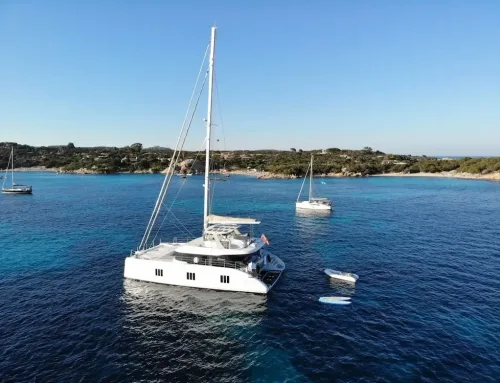
How do I plan a sailing route in Italy?

What are the sailing conditions like in Italy?

What is the cancellation policy for catamaran rentals in Italy?
Why Book With Us?
Competitive prices, Exceptional Service
ONLY Professional Charter Fleets
Rated 4.9/5 on Feefo
Super-low 25% deposit
Yacht v Catamaran
What are the main differences between sailing a yacht and a catamaran?
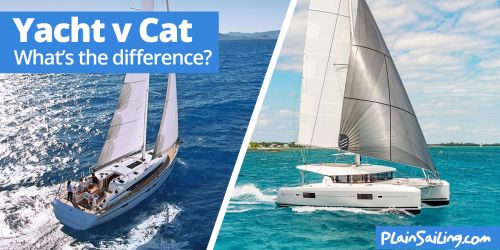
If you’re new to sailing (or even if you’re not) then you might be wondering what the main differences are between sailing a yacht or a catamaran – here’s a quick summary, from the obvious to the nuanced:
Shape / Number of hulls
The main difference is the shape of the boat: a yacht or traditional sailing boat has one hull (the bottom of the boat) which sits in the water, but a catamaran is a ‘multi-hull’ so has two hulls or points of contact with the sea, with a platform across the top which joins the two hulls together into one boat shape. The fact there are more hulls on a catamaran is the key difference between the boats, and everything else below derives from this.
The two hulls also mean that less of the catamaran is below the water, meaning that they can sail in shallower waters – as a result, in some parts of the Caribbean, they pretty much only charter catamarans.
Sailing Experience
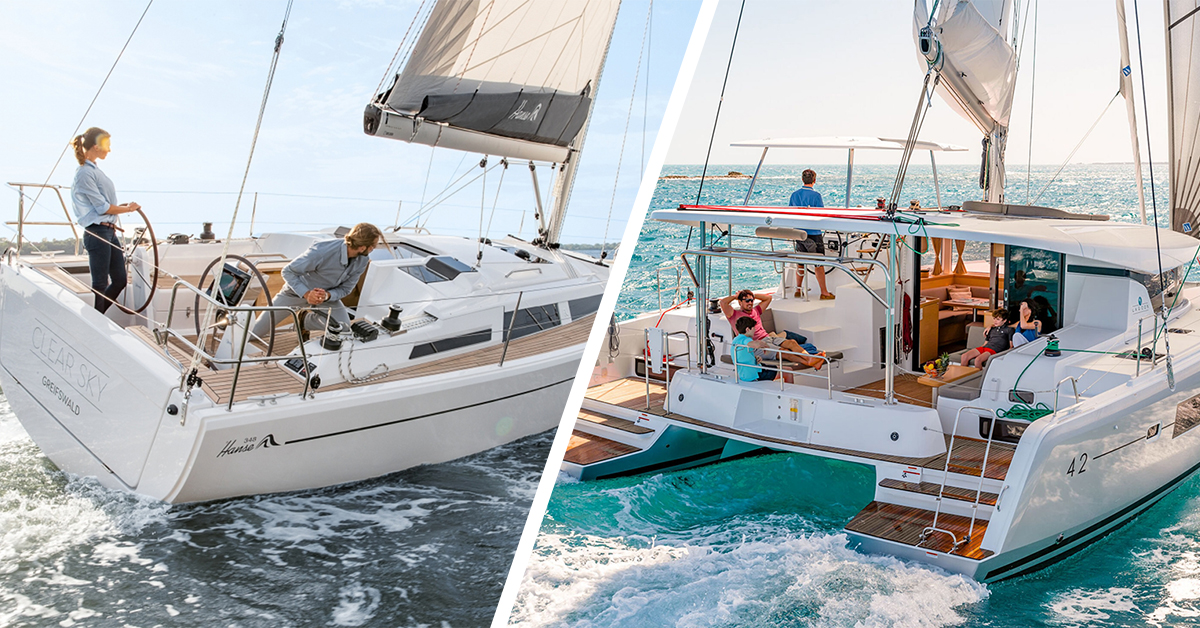
Whilst you’ll get more adrenaline on a yacht, the flip side of the sailing experience is that a catamaran, precisely because it has two hulls, is better balanced – so it is a lot more stable to sail on. It will move a little with the water, but it won’t heel over in the same way as a yacht, which makes it more predictable and better suited to beginners and for e.g. kids to find their balance and to walk around on deck when you are at sea.
So a catamaran is less exhilarating for the actual sailing bit, but you might decide that the pros more than outweigh this.
Manoeuvrability (in the marina)
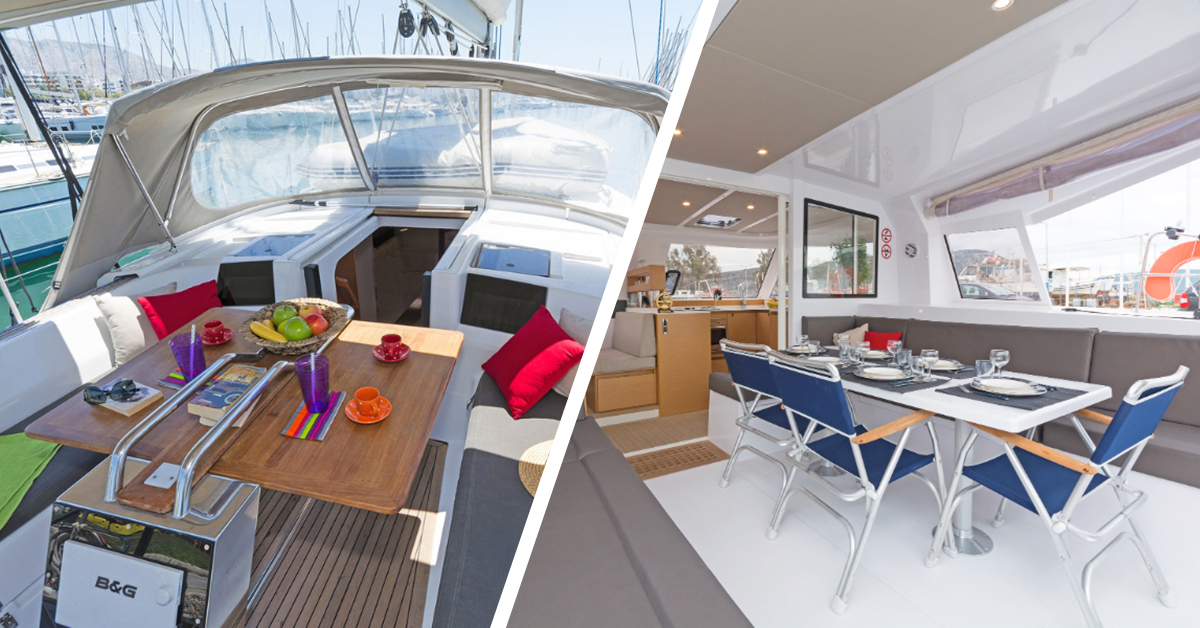
In addition, because there are two hulls, then the wind speed and direction have less of an impact on a catamaran (though the wind hits the windward hull the same as a yacht, the second hull helps to steady the ship, so it has a lot less effect).
A yacht, with a single motor to control speed and direction, and a single hull being blasted by the wind, is trickier to navigate at close quarters with other boats, and requires some experience or fore-thought (or both!) to moor up in a marina, particularly when conditions pick up.
Space on board and in the cabins / Comfort / Luxury
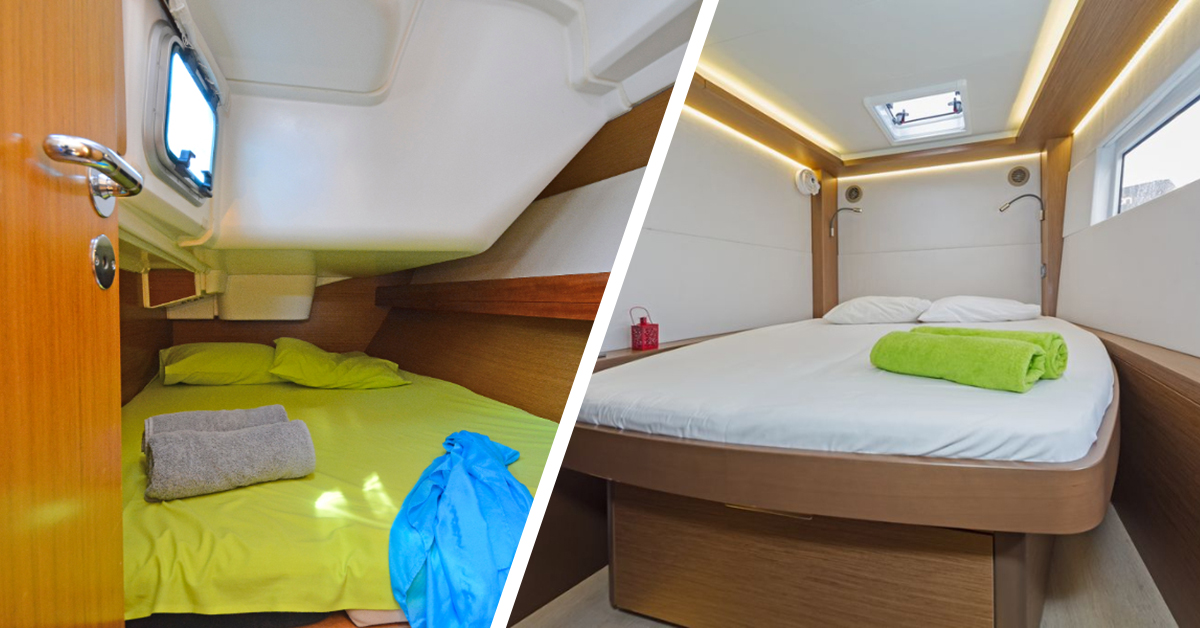
The extra width is used to create larger seating areas on a catamaran, more spaces to sit and socialise in (as opposed to just the cockpit or saloon area on a yacht), bigger cabins (and beds), more bathrooms (or ‘heads’) – often most cabins on a catamaran are en-suite, whereas on a yacht, you will likely be sharing two or three toilets between everyone on board.
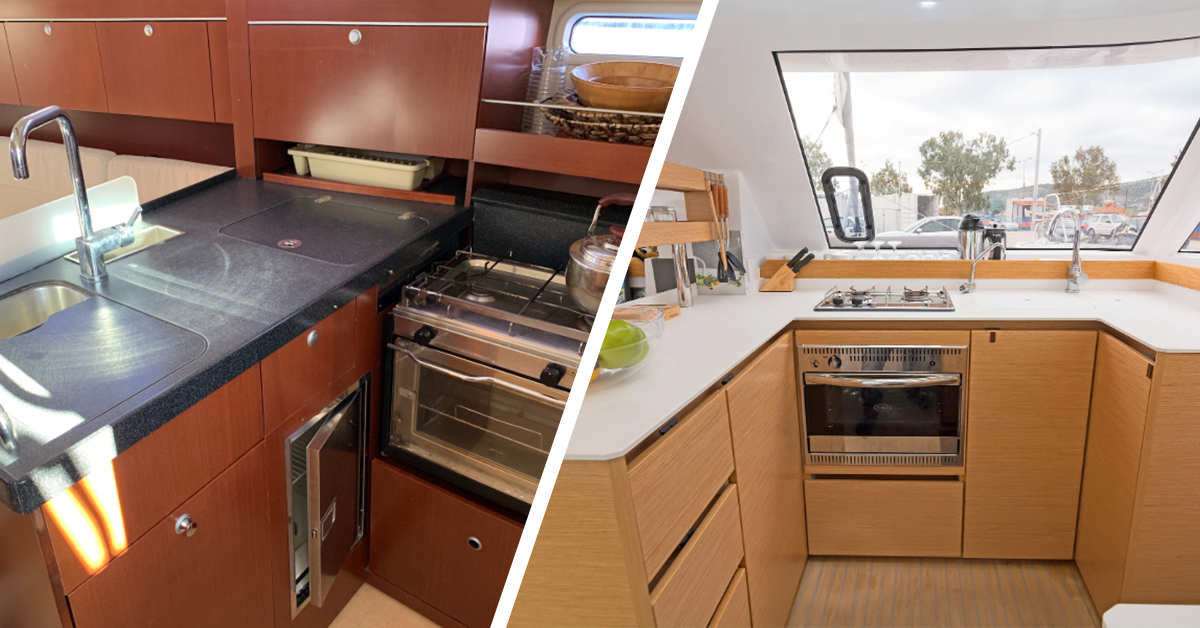
However, a yacht has been specifically designed to be the right size for the number of people on board - so they don’t feel cramped, and they have all the kit you need to enjoy a week away at sea. And one issue with all that space on a catamaran is that it’s possible to lose the closeness that comes from a week of forced shared time and togetherness spent in the heart of a yacht.
Price
As they are bigger and more expensive to buy, it costs more to charter a catamaran than a yacht – if you use the pink box and search ‘all’ then you’ll get a list of available boats for your week and PlainSailing.com base, which now shows both yachts and catamarans, and it’s easy to see the price difference (usually about 50% to 100% more).
Catamarans also attract larger marina fees (since they take up more space in the marina) for the nights you spend in a marina, and, with two engines, you’ll use twice as much fuel in a catamaran as you do in a yacht – which you will also have to factor into your costs.
PlainSailing.com recommends!
We can help you arrange a charter yacht or catamaran in Croatia, Greece, Italy, the Med, and in the Caribbean. What we'd recommend depends upon what type of sailor you are, and what sort of holiday you are after:
Catamarans are great for people considering a skippered charter, for people new to sailing, and for anyone sailing with kids (of any age) as they offer more space and luxury, and it is more like an exciting floating holiday home.
Yachts are fantastic for people who are on a sailing holiday for the thrill of the sailing, who like to ride the waves, and enjoy exploring and life at sea for a reasonable price.


Catamaran vs. Monohull Sailboats

When it comes to catamaran vs. monohull, there are two schools of thought that always prompt impassioned debates as to which one is much better.
If you've used both a catamaran (a boat with two hulls) and a monohull (a boat with one hull), you know that they both have pros and cons. In most cases, it all boils down to your personal preferences and intended use but that shouldn't prevent us from highlighting the better one.
A catamaran is much better than a monohull in many ways. Catamarans are more stable, faster, and spacious. They also offer safer anchorage and are easy to control. Monohulls are more maneuverable, have lower costs, and better when sailing upwind. It all comes down to personal preference and intended purposes, but when it's all said and done, a catamaran has more advantages than a monohull.
In this incisive article, we'll highlight the critical differences between a catamaran and a monohull and see the one that comes out on top.
Table of contents
Catamaran vs Monohull
Safety while out there on the water is one of the most critical things that any sailor should have in mind when choosing the type of boat to use.
Catamarans shine on many aspects of safety. They're generally more stable and seem to have natural buoyancy since they don't have ballast and this makes them almost unsinkable. Generally, catamarans are designed with a considerable amount of reserve buoyancy thanks to the crannies of the vessel, nooks, and closed-cell foam. These objects can, however, become a serious cause of safety concern should there be a fire outbreak. All in all, a cat can sink in an accident, but it'll most likely float on the surface of water unlike monohulls, which will sink to the bottom.
Again, catamarans have flat decks. This makes it a lot safer to walk on them than it would be to walk on angled decks of monohulls. Given their flat decks, a catamaran boat will stay level and have less pitching and so it's a lot easier to keep the crew aboard and safe even in rough weather.
Another important fact that may contribute to the safety of a catamaran is its speed. If you've always believed that speed equals safety, then a catamaran is the right boat for you. In short, the speed of a catamaran will allow you to outrun rough weather. A modern catamaran can clock nearly 250 miles a day, which is quite faster, and so there's no reason why you should get caught in bad weather.
In terms of safety, a monohull is nowhere near a catamaran as far as safety is concerned. The most important thing about a monohull in terms of safety is its self-righting capabilities. With a monohull, you're likely to return to an upright position even after capsizing and this can give you a chance of accessing onboard safety equipment, floatation devices, life raft, EPIRBS, dinghy, strobe lights, and many more.
Unfortunately, the same cannot be said of a catamaran. With a catamaran, you'll stay upside down once you're upside down and this can be fatal in the middle of the ocean.
Verdict: The self-righting capabilities of a monohull can be life-saving but it isn't guaranteed. On the contrary, a catamaran has loads of safety features chief among them is its unsinkability, so it easily comes out on top as far as safety is concerned.
Speed and Performance
If everything including length remains the same, a catamaran is about 30% faster than a monohull. A cat can sail at half the speed of wind but this will, of course, upon the angle of the wind. It remains the faster vessel and will allow you to arrive at your destination promptly. If anything, you can outrun bad weather with a catamaran.
Monohulls are generally designed to operate pleasantly with the sailing elements. This means that they won't fight these elements and will, in turn, offer slow but sure sailing. However, they do not have a lower wetted surface area and are certainly much slower when compared to catamarans. They can, nonetheless, be a great choice for sailing upwind.
Verdict: When it comes to speed, the catamaran wins hands down. No argument.
Needless to say, a catamaran is designed with two parallel hulls that give it a more reliable form of stability. This is crucial in preventing heeling and capsizing while also mitigating any chances of rolling when speeding. This stability is also of great importance in eliminating seasickness for passengers.
The level of stability that a catamaran has is one of the main reasons why capsizing is a very rare occurrence. A catamaran can lurch when the tops of the waves are at a certain distance, thereby leading to less bobbing.
The stability of a monohull will always be questioned, especially when compared to a catamaran. To put it into perspective, a monohull is four times more likely to capsize than a catamaran because its design means that it has less stability. If anything, a mono's single-beam design makes it seven times more likely to feel the effects of heeling than a catamaran of the same size. In essence, heeling is a major problem in monohulls.
Verdict: The high level of stability that a catamaran brings to sailing will make even a novice sailor feel more confident sailing on a catamaran. Differently, a monohull is less stable and seems to be in constant rolling and pitching motion, which makes it very unstable and unsafe to walk around the deck.
Maneuverability
In most cases, cats always have twin engines, set almost 20 feet apart. This will not only give you superb close control in tight situations but certainly removes the need for a bow thruster. While it may seem redundant to have twin engines on a cat, you'll appreciate the importance of the second engine if the first engine develops a mechanical issue while you're out there on the water.
The shallow drafts of the catamaran also play a major role in maneuverability in the sense that you can navigate into places where you can't get with a monohull such as close to the shore without thinking about running aground.
From a different point of view, a monohull can be better in terms of maneuverability since you won't be dealing with two hulls. A monohull can also make sharp turns and even sail through narrow channels and tight spaces, which is almost impossible with a catamaran. Additionally, a monohull has a higher hull displacement, which is essential in reducing the adverse effects of crosswinds, especially in tight conditions.
Verdict: The differences in terms of maneuverability are slight in both the catamaran and monohull. The fair verdict here is a draw.
Docking and Anchorage
With no ballast or a considerable keel, the overall weight of a cat is significantly reduced. This makes it more lightweight and this is why it wouldn't be uncommon for a 36+ foot catamaran to explore some of the shallow areas that a monohull wouldn't dare reach.
However, the wider and unique size of a cat means that it won't easily fit on a traditional slip and this needs a unique set of skills and careful planning to anchor at most docks. This means that finding the right space at the dock can be quite difficult, so you may have to take a dinghy to the shore.
A monohull is a lot easier to dock as it takes less space compared to a catamaran. This means that your docking, hauling, and slipping charges will be much less than those of a catamaran.
Verdict: Does it make any sense to bring two boats to the shore? Well, this is what you do when you have a catamaran and it certainly loses to the mono as far as docking and anchorage are concerned.
Ride Comfort
A comfortable ride is, without a doubt, one of the most important things to consider when looking for the right boat for you.
The fact that a catamaran is designed with a wider footprint is of great importance in mitigating the negative effects of unpredictable rolling and pitching that sailing is known for. A catamaran has a broad surface area, which makes it more comfortable and stable. As such, it's a lot easier and safer to cook while sailing.
Again, your passengers will be less prone to seasickness in a catamaran because there's less pitching and a cat doesn't roll from swell to swell as it happens in a monohull. That's not all; walking on the deck of a catamaran is a lot easier and safer since the boat is flat. This makes reefing much easier and safer and your chances of falling overboard are greatly reduced. More importantly, it's more pleasurable to sleep in a catamaran because it never heels.
In terms of ride comfort, a monohull offers smooth sailing as it doesn't slap or pound the water like a catamaran. This is because it works harmoniously with the sailing element and doesn't fight it like a catamaran, especially when sailing upwind. However, seasickness brought about by constant rolling and pitching of a monohull.
Verdict: If you want to have a comfortable sailing ride, a catamaran has many benefits than a monohull as long as it has a superb bridge deck clearance that disperses wave action.
Maintenance
A catamaran is general designed with two of everything. From the two hulls to the two engines, you seem to get things double, which can be reliable when sailing if there's an issue with one part. In other words, you always have a backup.
However, the costs of maintenance can be high if you have to maintain the boat, even though you can still use one part if the other part isn't working.
The fact that you only have single parts means that you have to be very careful and ensure that your monohull vessel is maintained or repaired regularly. Fortunately, the costs of maintenance and repairs are greatly reduced when compared to those of a catamaran.
Verdict: It's highly doubtful that you'll take your catamaran out if one of the two hulls or engines are faulty. The monohull wins this.
The costs of a catamaran are substantially high since everything seems to come in pairs. However, catamarans are known to have high resale values, very low depreciation rates, and can sell a lot faster than monohulls because they're more popular with modern sailors. But because catamarans aren't widely manufactured in the United States, their costs are still high as you'll have to include the delivery costs.
When deciding to buy a monohull vessel, you should keep in mind that they're widely available on the market so their costs might be a bit lower compared to catamarans. Again, their low maintenance cost will work to your advantage.
Verdict: The costs of buying and maintaining a monohull are quite low, so it's the best choice if you're on a tight budget but still want to enjoy sailing. Catamarans are very costly to build and are more expensive than monohulls.
The amount of deck space afforded by a catamaran is huge and always very spacious. The amount of space that a cat can afford you is one of the main reasons why you should choose it if you're looking for comfort or planning to live aboard the vessel.
On the contrary, monohulls are narrower when compared to catamarans; hence they have a very limited deck space. This is particularly mitigated by the fact that they have additional storage space.
Verdict: A catamaran has a lot more deck space and wins on this.
Load Distribution
Unlike monohulls, catamarans are rectangular and are more stable. This is essential in giving the passengers more freedom without necessarily having to worry about how their weight is distributed inside the boat.
A monohull is almost similar to standing on one leg and balancing can be quite overwhelming. This means that the weight of the passengers will have to be evenly distributed to ensure that the boat is balanced. Of course, this will limit the freedom of passengers and any imbalance might make the boat capsize.
Verdict: You don't have to worry about load distribution in a catamaran but this can be a negative issue in a monohull.
Fuel Efficiency
If you want to save money by reducing the fuel costs, a catamaran is an ideal option. A cat generally experiences little drag or resistance and doesn't need lots of fuel to move. They also have a steady rise in speed, which means that there will be no sudden increase in fuel consumption.
In comparison, the level of drag created due to greater displacement in a monohull vessel means that there will be a higher resistance and this translates to higher fuel consumption.
Verdict: A monohull consumes more fuel than a catamaran, so a cat is an ideal option if you're looking for fuel-efficiency.
In Conclusion
To this end, it's easy to see that a catamaran comes out on top as the best option on many fronts. This doesn't mean that a monohull doesn't have its advantages. Of course, it has both advantages and disadvantages just like a catamaran does.
And even though the catamaran comes out on top, the final decision is on you and may depend on your personal preferences. Whatever you choose, make sure that you enjoy your sailing vacation.
Related Articles
Daniel Wade
I've personally had thousands of questions about sailing and sailboats over the years. As I learn and experience sailing, and the community, I share the answers that work and make sense to me, here on Life of Sailing.
by this author
Learn About Sailboats
Most Recent

What Does "Sailing By The Lee" Mean?
October 3, 2023

The Best Sailing Schools And Programs: Reviews & Ratings
September 26, 2023
Important Legal Info
Lifeofsailing.com is a participant in the Amazon Services LLC Associates Program, an affiliate advertising program designed to provide a means for sites to earn advertising fees by advertising and linking to Amazon. This site also participates in other affiliate programs and is compensated for referring traffic and business to these companies.
Similar Posts

Affordable Sailboats You Can Build at Home
September 13, 2023

Best Small Sailboat Ornaments
September 12, 2023

Discover the Magic of Hydrofoil Sailboats
December 11, 2023
Popular Posts

Best Liveaboard Catamaran Sailboats
December 28, 2023

Can a Novice Sail Around the World?
Elizabeth O'Malley
June 15, 2022

4 Best Electric Outboard Motors

How Long Did It Take The Vikings To Sail To England?

10 Best Sailboat Brands (And Why)
December 20, 2023

7 Best Places To Liveaboard A Sailboat
Get the best sailing content.
Top Rated Posts
© 2024 Life of Sailing Email: [email protected] Address: 11816 Inwood Rd #3024 Dallas, TX 75244 Disclaimer Privacy Policy

Catamaran Vs. Motor Yacht (4 Powerful Differences Explained)
- Post Written By: Boater Jer
- Published: July 13, 2022
- Updated: September 25, 2022
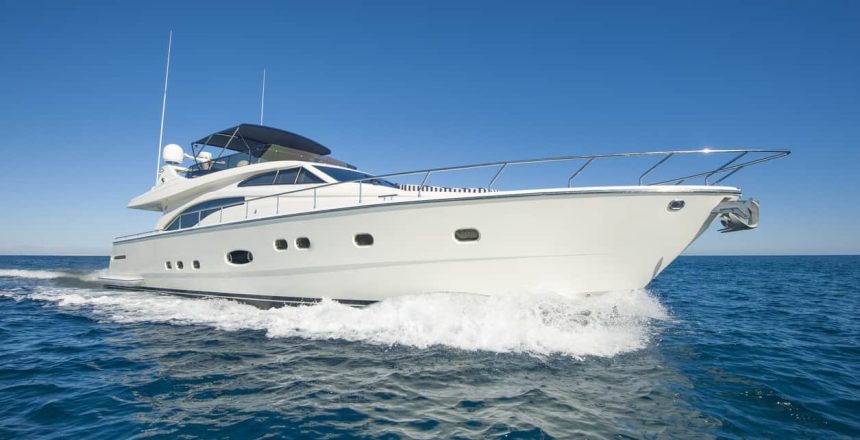
Disclaimer: You might notice that we recommend products in some articles. We may earn a commission for referring you if you click the link and buy a product.
We only recommend products we’ve tried/tested/own (that’s why you won’t find thousands of affiliate links on my site). If you have experience with one of the products we’ve mentioned, please share your experiences in the comments at the end.
The Catamaran Vs. motor yacht, a comparison that has lasted for ages, is one we will finally put to rest in this article. We promise to make spotting their differences easy.
Differences Distinguishing the Catamaran Vs. Motor Yacht
At the end of this section, everything that distinguishes these two sailing boats from each other will be at your fingertips.
The Shape And Number Of Hulls
As you must be aware, motor yachts have mono hulls, while catamarans (CATS) have multi-hulls.
But what does this mean?
First, you need to understand that a boat’s hull refers to the body of the watercraft. It sits on top and also lies below the water.
The mono hull takes a V-shape, and most of the bottom of the hull will be underwater. However, when dealing with CATs (multi-hull) systems, you’d notice a planning or displacement hull system. ( source )
Only a tiny section of the hull’s bottom will be below the water with these hulls. It makes the catamaran perfect for shallow water sailing. ( source )
The presence of the multi-hull system in the catamaran is the basis for most of its advantages. Some of which include;
- Better stability when docked and when underway
- Saving fuel costs when the weather is favorable
Number Of Engines
The number of engines in the catamaran and motor boat is another crucial player that determines the difference in performance.
Cats often feature twin engines which translate to higher speed and better maneuverability. Not to mention that if one engine fails, you have a backup engine. ( source )
These Catamarans and their dual engines are also known to sail faster downwind. It is traceable to the shallow immersion of the hulls, which means less drag. ( source )
However, when placed in an upwind sailing showdown, the motor yacht wins. It is because the undercarriage will experience pounding and slapping. ( source )
Available Space And Comfort
The difference in available space is as clear as day. It is because of the difference in the hull shape.
The catamaran has ample space in areas like the salon, galley, and flybridge. Even its cabins are more comfortable, and you’d be able to sit upright. Also, unlike the motor yacht, several cabins in a catamaran are ensuite.
Additionally, comfort is a priority on the catamaran. It can fit larger electronic appliances like fridges, dishwashers, and freezers. Besides, you can finally say goodbye to sea sickness caused by wave impact with the CAT. Accelerometer tests show that catamarans have a 25% reduction in G forces. ( source )
Pricing And Cost
Also quite clear is the margin in the cost of purchasing or chartering a catamaran . Compared to a motor yacht, you’d find that you’d be spending more on the catamaran.
Additionally, since catamarans are larger, you’d spend more to get a berthing space in the marina. But you also should know that the catamaran is not all cons and no pros in terms of cost and pricing. After all, it suffers only a slight reduction in resell value.
Final Thoughts
We’ve informed you about the differences between a catamaran and a motor yacht. Ensure you consider the time of the year you plan sailing, your budget, and the number of people on board before opting for either of these sailing choices.
- Latest Articles
- Article Sources
- Crab Island by Pontoon: A Fun Watery Boating Guide Destination in 2024
- Upgrade Your Boating Experience: Adding a Third Pontoon Made Easy!
- How Long Does It Take A Canoe To Go… (Canoe Calculator Here)
- In-Depth Review of the Pelican Sentinel 100X Fishing Kayak: Pros, Cons, and Performance
- How To Put A Kayak In The Water – The Ultimate Guide For New Kayakers
- What are the main differences between sailing a yacht and a catamaran? https://plainsailing.com/blog/yacht-v-catamaran
- Catamarans versus Monohull yachts – why the popularity of catamarans is growing https://yachtharbour.com/news/catamarans-versus-monohull-yachts—why-popularity-of-catamarans-is-growing-4152?src=news_view_page_bar
- Powered Catamarans Vs. Monohull Motor Yachts https://infinityyachtsales.com/2021/10/powered-catamarans-vs-monohull-motor-yachts/
- Sailing Catamaran Vs. Sailing A Monohull Yacht, https://www.sailingeurope.com/en/sailing-tips/sailing-catamaran-vs-sailing-monohull-yacht
- POWER CATAMARAN vs. MOTOR YACHT https://makaiyachts.com/power-catamaran-vs-monohull/
- The Best Type of Yacht to Charter https://www.212-yachts.com/the-best-type-of-yacht-to-charter-guide/
- Learn The Difference Between a Catamaran vs. Yacht Charter https://sailchecker.com/catamaran-vs-yacht/
- Boat Hull Types & Designs https://www.boaterexam.com/boating-resources/boat-hull-types-designs/#:~:text=%22V%2Dshaped%22%20hulls%20are,flat%20or%20round%2Dbottomed%20boats .
panerai replica
Share this post with your friends, subscribe to our newsletter.
Join us in our love for all things water. And Adventure.

Everything You Need To Know About Boat Anchors (A Quick Read)
Most people enjoy being on boats. The smell of the water, the feel of the wind in your hair, and being around people you enjoy. It can make for a fun day. But at the end of the day, when you pull the boat back to shore, you will have to make sure that your boat stays in place. This is the job of the boat anchor.

Can Sailboats Go Against The Wind? Here’s How!
Can sailboats go against the wind? Let’s find out! There is a saying that you can’t change the direction of the wind and would have to adjust your sail; how true of it. One cannot alter the wind’s current by will or any other method; that is why one should adjust their sail accordingly. Generally,

Do Kayaks Tip Easily?
Do kayaks tip easily? I wondered this myself when I first started kayaking years ago. Learning to kayak is like learning to ride a bicycle. It would be best to learn how to balance a position that may not be part of everyday life. It is a learned sense of balance that only comes with

How Fast Can Canoes Go? We Find Out (With World Records).
Sliding over the glass-like stillness of a peaceful morning lake, a ride in the canoe is an incredible experience. The mist rising slowly off the water and wildlife waking to the coming day can be a nearly magical experience for the canoeist. However, it may not be only about peace and tranquility. If you like

Qysea Fifish V6 Underwater Drone Review
Are you an aspiring Youtuber who needs to use an underwater drone while shooting? Do you need an efficient underwater drone for professional purposes? Or are you simply a drone enthusiast who likes nothing but the best? Whatever may be your specific need for an underwater drone, we have a fantastic recommendation for you- the

Do Flat Bottom Boats Have Titles?
Have you ever wondered if Flat Bottom Boats have titles? It’s a perfectly valid question, and essential to know if you plan on purchasing a flat bottom boat or already own one. Or maybe you have a different kind of boat and are wondering about the need for a title? A title is a document

Boat Information By Type
© 2023 Boating.Guide, A Hyperwave Media Group Ltd. Publication.
Privacy Overview
Catamarans: A Complete Guide to Multihull Boats
Catamarans have been a part of sailing history for centuries and continue to be popular for their stability, spaciousness, and performance. Developed by various cultures around the world, the principles of catamaran design have evolved over time to become optimized for both pleasure cruising and racing. This complete guide will help you understand the essentials of catamarans, their unique characteristics, and how to choose the right one for your needs.

From the basic concepts of multihull design, performance, and handling, we will explore the advantages and benefits of a catamaran in terms of safety and comfort on board.
Along the way, we will discuss maintenance considerations, distinctive catamaran brands and models, and how a catamaran lifestyle can compare to more traditional sailing options .
Finally, we will provide learning resources and frequently asked questions tailored to both seasoned sailors and newcomers to the world of catamarans.
Key Takeaways
- Catamarans are known for their stability, spaciousness, and performance
- This guide covers aspects like design, handling, safety, and choosing the right catamaran
- Resources and frequently asked questions provide additional insights for potential catamaran owners
Understanding Catamarans
Design Characteristics
Catamarans are known for their unique design, which features two parallel hulls connected by a deck. This design provides several advantages over traditional monohull boats, such as stability and speed.
With their wide beam, catamarans have a reduced risk of capsizing and can access shallow waters due to their shallow drafts 1 .
One of the notable aspects of a catamaran is its twin hulls, which offer increased living space and comfort compared to a monohull. Additionally, catamarans are often favored by recreational and competitive sailors for their excellent maneuverability 2 .
The materials used for constructing catamarans range from wood to fiberglass, and even aluminum for high-performance vessels. Aluminum catamarans are known for their strength, lightweight structure, and resistance to corrosion 3 .
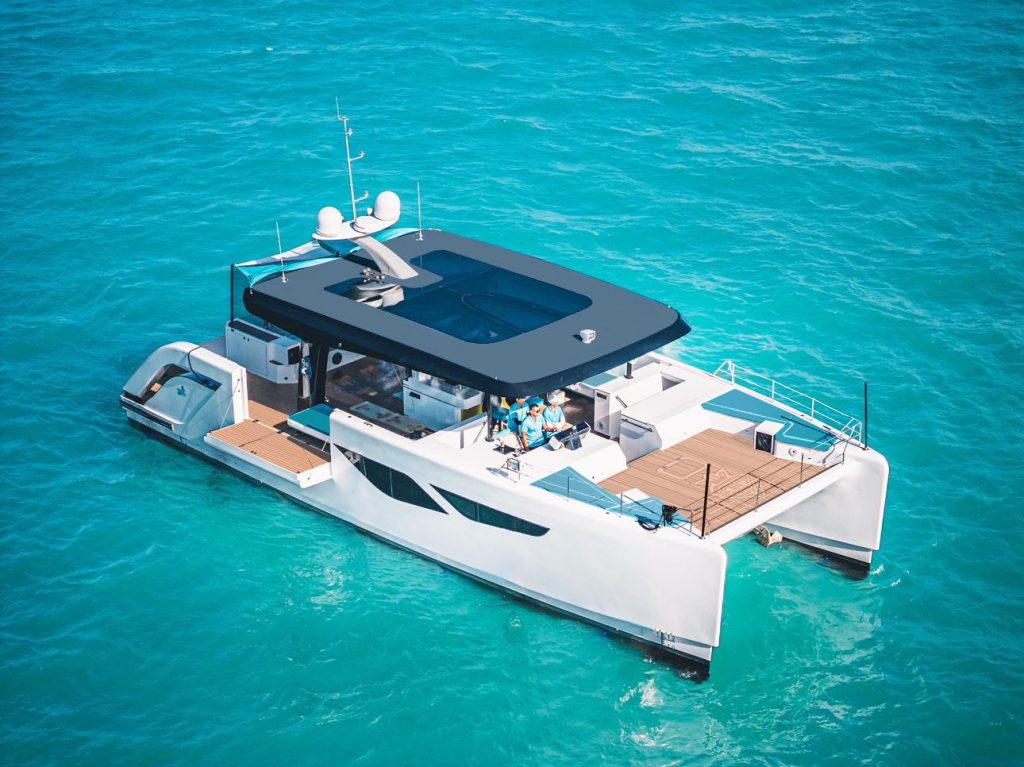
Hulls and Construction
The hulls in a catamaran are crucial to its stability and performance. These hulls help distribute the weight evenly across the water surface, minimizing drag and allowing for smoother sailing.
In general, the hulls can be categorized into two types:
- Symmetrical Hulls : The hull shape is similar on both sides, which enhances balance and stability in various sailing conditions.
- Asymmetrical Hulls : One side of the hull is designed differently than the other, which can be advantageous when sailing upwind.
The construction materials used in building catamaran hulls also play a vital role in the boat's performance and durability. Common materials include:
- Fiberglass : A popular choice due to its lightweight, strength, and ease of maintenance.
- Wood : Traditional material that offers a classic look, but requires more maintenance than fiberglass or aluminum.
- Aluminum : Lightweight and strong, aluminum is an excellent choice for high-performance catamarans 4 .
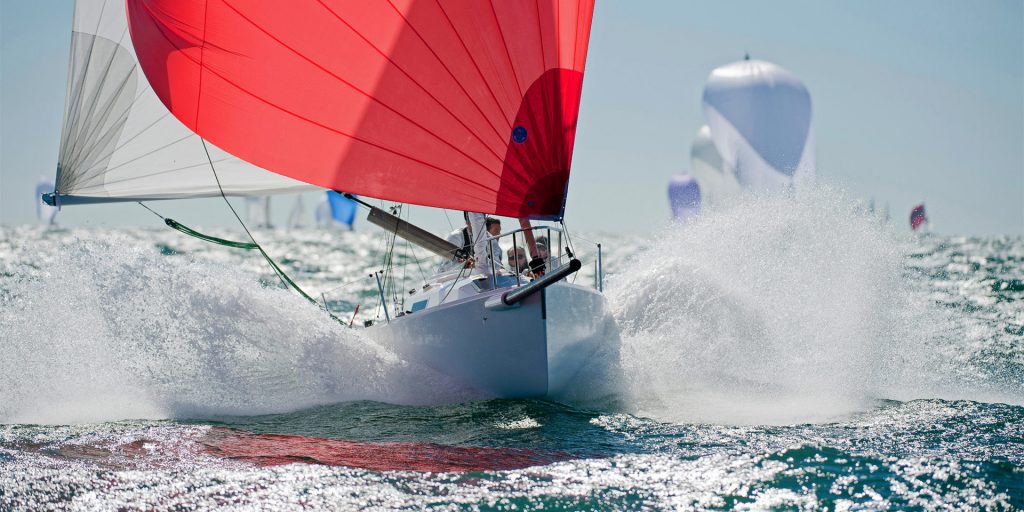
Multihulls vs Monohulls
There's often a debate between the benefits of multihull boats, such as catamarans or trimarans, and monohull boats. Here are some key differences between the two:
- Stability : Due to their wide beam and reduced heeling, catamarans offer improved stability compared to monohulls. This makes them an attractive option for those who want to avoid seasickness or feel more comfortable on the water 5 .
- Speed : Multihull boats are known for their speed, which results from their ability to minimize drag and maintain a level sail.
- Living Space : Catamarans and other multihulls generally have more living space, as both the hulls and the connecting deck can be utilized for accommodation and storage.
- Maneuverability : While monohulls are known for their agility and ability to point close to the wind, catamarans can still offer exceptional maneuverability when properly sailed 6 .
Performance and Handling
Speed and Efficiency
Power catamarans have gained popularity for offering a unique combination of speed, efficiency, and stability. Their dual-hull design allows for less water resistance, which directly translates to higher speeds and better fuel efficiency compared to traditional monohull boats.
In addition, the wide beam provided by the two hulls ensures a stable ride even at higher speeds. This makes power catamarans ideal for cruising, fishing, and watersports ( Boating Beast ).
Sailing Dynamics
When it comes to sailing catamarans , the performance is affected by factors such as keel, rudders, mast, and sails.
Their wide beam and dual-hull design provide inherent stability and reduced heeling effect, making them less likely to capsize compared to monohulls.
I should also note that catamarans have a shallow draft, which gives them the ability to access shallow waters that may be off-limits to other boats ( Navigating the Waters ).
In my experience, the lighter weight of a catamaran and its aerodynamic design can contribute to remarkable sailing performance under different wind conditions.
The larger sail area relative to hull weight allows them to harness more wind power, further enhancing their speed and agility on the water.
Maneuvering and Docking
Maneuvering and docking a power catamaran involves understanding its unique handling characteristics.
The presence of two engines in separate hulls allows for more precise control in confined spaces such as marinas.
The maneuverability of these boats is typically improved by the use of dual rudders that are located close to each powered hull for efficient steering ( BoatUS ).
When docking under power, I find it helpful to carefully assess the wind and current conditions beforehand.
This is because catamarans can be more sensitive to windage due to their larger surface area above the waterline.
By understanding how these forces may affect the boat, I can make adjustments to my approach and successfully dock the catamaran without any incidents.
Safety and Comfort on Board
Safety Features
Safety is a top priority when sailing any type of vessel, including catamarans. A well-built catamaran offers several features aimed at ensuring the safety of those onboard.
First, catamarans have inherent stability due to their wide beam and twin hull design . This makes them less prone to capsizing than monohull boats. This stability allows me to confidently navigate various water conditions .
In addition to stability, catamarans are designed with positive buoyancy, making them almost unsinkable . Of course, safety equipment such as lifejackets, flares, and first aid kits should always be onboard and well-maintained.
Furthermore, you should also stay updated on weather conditions, avoid sailing in high-risk areas, and learn your boat's safe sail limits.
Living Spaces and Comfort
When it comes to living spaces, I value comfort and practicality as essential features for my time on the water. Catamarans offer a unique advantage in this regard, as their dual hulls create spacious living areas.
Most catamarans are designed with separate cabins in each hull, allowing for privacy and comfort when sleeping. Additionally, these boats typically feature shallow drafts , which means I can access shallow waters and anchor close to shore.
The main living area, or salon, is situated on the bridge deck between the hulls. It usually includes a seating area, a dining table, and a galley (kitchen). Large windows provide ample natural light and panoramic views, making the space feel open and bright. Some catamarans even have the option for an additional living area on the upper deck where you can enjoy the sun and breeze.
One aspect of catamaran living I truly appreciate is the ample storage available. Each cabin typically has built-in storage spaces for clothes, gear, and personal items. There are also designated areas for equipment such as spare sails, tools, and water toys. This makes it easy for me to keep my belongings organized and make the most of my time on the water.

Maintaining a Catamaran
Routine Maintenance
In order to keep my catamaran in the best possible shape, I make sure to perform routine maintenance tasks. These tasks are essential to extend the life of the components and ensure smooth sailing:
- Cleaning : Regularly cleaning the deck, hulls, and sails prevents buildup of dirt, algae, and other debris that could affect performance.
- Inspection : Periodically inspecting my catamaran allows me to detect any potential issues before they become significant problems. I pay close attention to the rigging, sails, and lines on my boat.
- Lubrication : Keeping all moving parts lubricated is vital to prevent friction and wear on components such as winches and pulleys.
- Antifouling : Applying antifouling paint to the hulls of my catamaran helps prevent the growth of marine organisms that can damage the boat and reduce its speed. Make sure to do this at least once a year.
Dealing with Wear and Tear
Despite my best efforts to keep my catamaran well-maintained, wear and tear is inevitable. Here's how I deal with common issues that could arise from regular use:
- Repairs : When I notice signs of wear on sails, lines, or rigging components, I make it a priority to repair or replace them promptly. Neglecting these issues can lead to more significant problems and affect the boat's performance.
- Hull maintenance : If I find dents, scratches, or stiff rudders on my catamaran's hulls, I address them immediately. Repairing any damage not only ensures smooth sailing but also prevents further issues from developing.
- Sail care : Over time, my sails can become stretched, torn, or damaged due to exposure to sun, wind, and saltwater. Regularly inspecting them for signs of wear and making any necessary repairs or replacements helps maintain optimal performance.
- Rust and corrosion prevention : Since my catamaran is made of various metal components, I need to protect them from rust and corrosion. I routinely check for signs of corrosion and apply anti-corrosive treatments when needed.
Catamaran Brands and Models
High-Performance Models
In recent years, there has been a growing interest in high-performance catamarans. I have seen a variety of brands and models that have impressed me with their performance capabilities. One notable brand is Fountaine Pajot , which has a long history of producing a range of sailing catamarans and power catamarans. Some of their popular models include the Tanna 47 and the Bali 4.4 .
Another high-performance catamaran I've come across is the Leopard 40 . Known for their speed and exceptional handling in various conditions, the Leopard brand started with sailing catamarans and has since expanded to include power catamarans. Their models range from 40 to 53 feet long, offering both power and luxury for those looking for a thrilling experience on the water.
Cruising Catamarans
When it comes to cruising catamarans, the Lagoon brand is synonymous with luxury and comfort. With a range of sailing catamarans from 40 to 70 feet long, Lagoon offers spacious catamarans for extended bluewater cruising. Their 60- and 70-foot power catamarans are equally impressive, providing ample living space and smooth sailing experiences.
I've also found the Aquila 42 PC to be a remarkable cruising catamaran. With a focus on design and innovation, Aquila has produced catamarans perfect for exploring the open sea with friends and family. Their spacious, stable designs allow for a more enjoyable and serene journey, ensuring you arrive at your destination comfortably.
The Catamaran Lifestyle
Anchoring and Cruising
I find catamarans to be a fantastic choice for cruising and anchoring , which is a critical part of living the catamaran lifestyle . Catamarans have several advantages when it comes to anchoring and cruising, such as:
- Stability : Due to their wide beam and twin hulls, catamarans remain stable during anchoring, which reduces the risk of seasickness.
- Shallow draft : Thanks to their shallow draft , catamarans can anchor close to shore, enabling better access to protected coves and more beautiful beaches.
- Speed : Despite their large size for cruising vessels , catamarans are generally faster than monohulls. This is a result of their slim hulls and reduced water resistance.
When it comes to anchoring, catamarans can make use of their shallow draft to anchor in locations that other boats cannot. This allows for a greater range of cruising spots, which makes the overall experience much more enjoyable and unique.
Living on a Catamaran Full-time
For many catamaran enthusiasts, the dream of living full-time on a catamaran is entirely possible. While not without challenges, there are several factors that make living aboard a catamaran an enjoyable experience:
- Spacious living areas : Catamarans generally have more living area compared to monohulls, providing ample space for the whole crew.
- Privacy : The separate hulls allow for private cabins, ensuring that everyone on board has their space.
- Stability : As mentioned earlier, catamarans are stable vessels, making living on them more comfortable than monohulls.
Choosing Your Catamaran
Comparing Models and Features
When I start to look for the perfect catamaran, the first thing I focus on is comparing various models and features .
I determine the key factors that are essential for my needs, such as size, passenger comfort, and performance. By doing so, I can identify which catamaran models are most suitable for me.
For example, if I plan to sail with a large group, I would look for a catamaran that offers ample space both inside and out.
To help me with my comparisons, I usually create a table or list of the different models and their features:
| Model | Size | Comfort | Performance |
|---|---|---|---|
| A | 40ft | Spacious | High |
| B | 35ft | Average | Average |
| C | 45ft | Luxury | High |
This visual aid makes it easier for me to sort the options and prioritize my considerations, such as price, yacht type, and brand.
New vs. Second-Hand
Another critical aspect of choosing a catamaran is deciding between a new or second-hand boat.
Both options have their pros and cons, and ultimately it depends on my preferences and budget.
If I can afford a new catamaran, I get the advantage of the latest design , features, and technology. Plus, I typically receive better warranty coverage and support from the manufacturer.
However, new catamarans are more expensive and can have long wait times due to high demand.
On the other hand, purchasing a second-hand catamaran can save me a significant amount of money, and I might find a high-quality boat with low mileage or well-maintained by the previous owner.
However, this option carries more risks, as I need to be knowledgeable about potential maintenance issues and conduct a thorough inspection before purchase.
Learning Resources
Books and Manuals
When it comes to learning about catamarans, there are plenty of books and manuals available.
One of the highly recommended books is Multihull Voyaging by Thomas Firth Jones. This book provides a comprehensive understanding of multihulls, including catamarans, and is an essential guide for any beginner sailor.
Another great book to check out is Catamarans: The Complete Guide for Cruising Sailors by Gregor Tarjan.
With a foreword by Charles K. Chiodi, publisher of Multihulls Magazine, this book covers all aspects of cruising catamarans. It includes detailed information on design, construction, and maintenance, as well as tips and tricks for sailing a catamaran.
Here are a few more books that I find valuable:
- The Catamaran Book by Tim Bartlett, an excellent resource for both beginners and experienced sailors
- Catamaran Sailing: From Start to Finish by Phil Berman and Lenny Rudow, a comprehensive guide to both catamaran racing and cruising
Online Content and Photography
In addition to books, you can find plenty of online content and photography about catamarans.
Websites like Sailaway Blog and Boating Guide offer tips, techniques, and how-to articles for sailing catamarans.
Many of these sites also include stunning photography, showcasing these beautiful vessels in action.
For those who prefer Kindle or e-books, many of these resources are available in digital format.
This makes it easier for you to access them anytime, anywhere, allowing you to keep learning and improving your catamaran sailing skills.
To further enhance your knowledge, you can also join online forums and communities dedicated to catamarans.
These platforms provide invaluable advice and first-hand experiences shared by fellow sailors, as well as recommendations for additional learning resources.
Frequently Asked Questions
What factors should be considered when choosing a catamaran for full-time living?
When choosing a catamaran for full-time living, consider its space and layout , as it will become your home.
Look for a design with a comfortable living area , ample storage, and sufficient berths for the number of people living aboard.
Also, consider fuel efficiency , ease of maintenance, and the catamaran's cruising range .
Lastly, the overall cost of ownership , including insurance and mooring fees, should be considered.
How do catamarans perform in rough sea conditions?
In general, catamarans are known for their stability, which is primarily due to their wide beams. This makes them less prone to capsizing when compared to monohulls.
However, their performance in rough sea conditions will depend on the specific model and design of the catamaran. Some may perform better in certain conditions than others, so researching and selecting the right design is essential.
What are the key differences between sailing a catamaran and a monohull?
One of the main differences between catamarans and monohulls is stability.
Catamarans have a wider beam , which makes them more stable and minimizes the risk of capsizing.
They also have shallower drafts, which allow them to access more shallow waters compared to monohulls.
Additionally, catamarans often have larger living spaces, making them more comfortable and suitable for cruising and full-time living.
What are the advantages of catamarans for long-distance cruising?
Catamarans offer several advantages for long-distance cruising.
Their wide, stable design provides a comfortable ride and reduces the risk of seasickness.
They can also attain higher speeds due to their reduced drag and generally sail faster than monohulls on certain points of sail.
The shallow draft allows them to explore more coastal areas and anchor closer to shore. Lastly, their spacious interiors make them ideal for extended cruises and living aboard.
How does one assess the value of a used catamaran on the market?
Assessing the value of a used catamaran requires thorough research and inspection.
Start by comparing the age, model, and condition of the catamaran to similar listings on the market.
Take note of any upgrades or additions made to the boat, as these can affect the price.
It's essential to inspect the boat in person or hire a professional surveyor to ensure there are no hidden issues that could affect its value.
What essential features should be looked for in a catamaran intended for ocean voyages?
For ocean voyages, look for a catamaran with a strong, well-built hull designed to handle rough conditions.
Safety features such as liferafts, adequate flotation, and sturdy deck hardware are crucial.
A reliable engine and well-maintained rigging and sails are also essential.
In terms of living space, opt for a catamaran with a comfortable, spacious interior and ample storage.
Last but not least, good navigation and communication systems are necessary for long-distance ocean voyages.
Related Articles
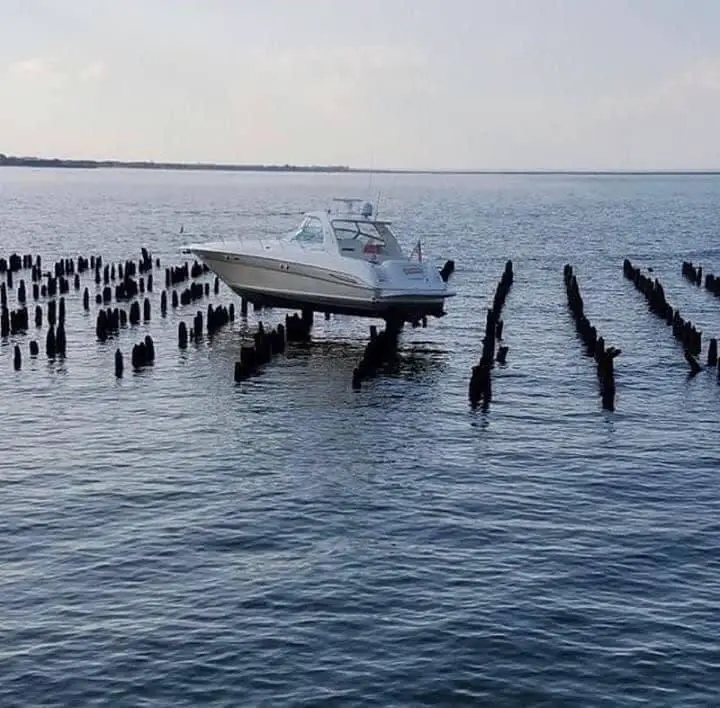
Talk About A Cheap Dry Dock

Top 10 Freedom Boat Club Locations: Best Spots for Boating Enthusiasts

Setting Hook Broughtons

Top 10 Alumacraft Boats for Sale Illinois

Top 5 Small Sailboats: Compact Cruisers for Weekend Warriors
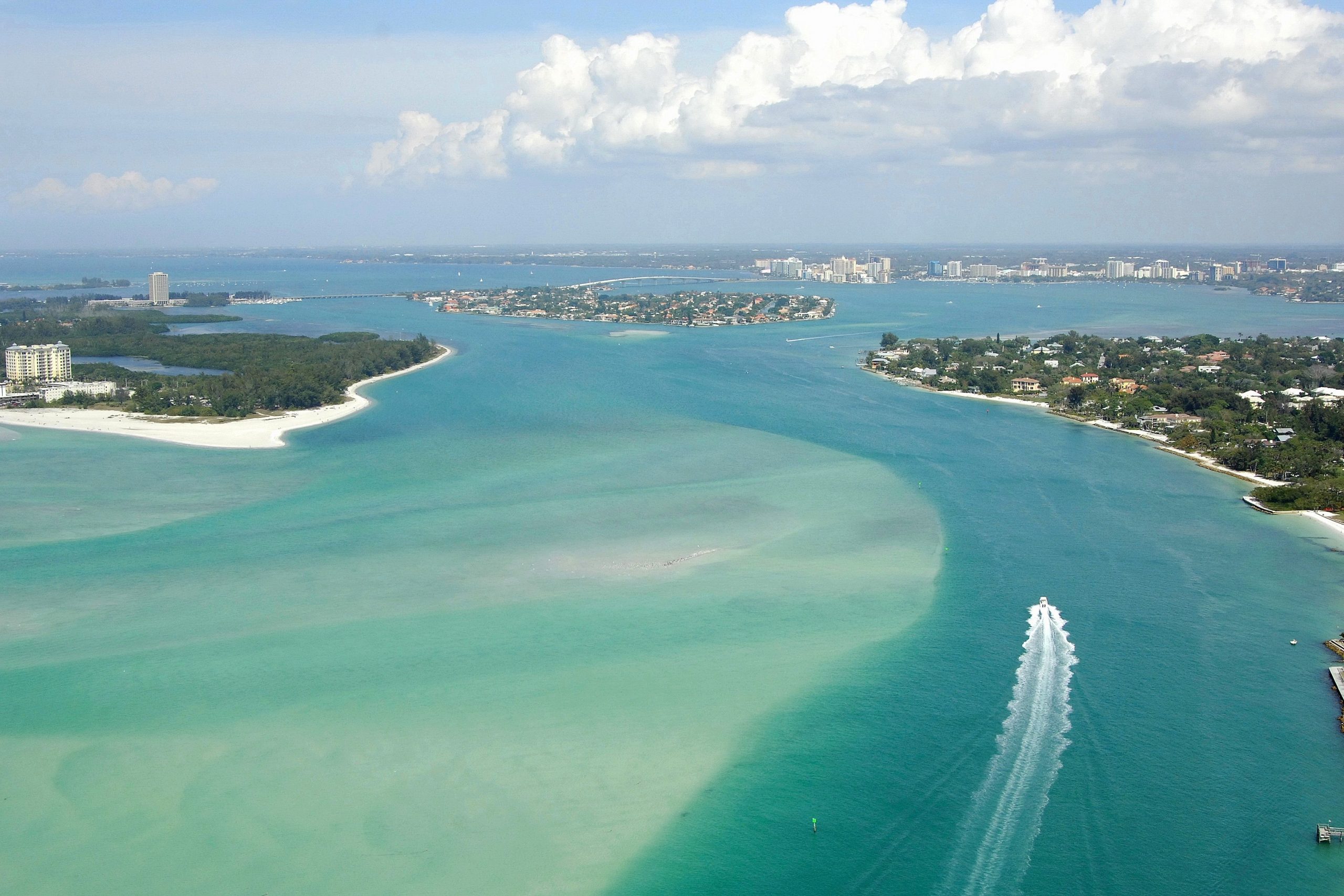
Big Pass Sarasota: A Hidden Gem for Thrill-Seeking Boaters

Stellar Kayaks: Top Choices and Expert Insights for 2024
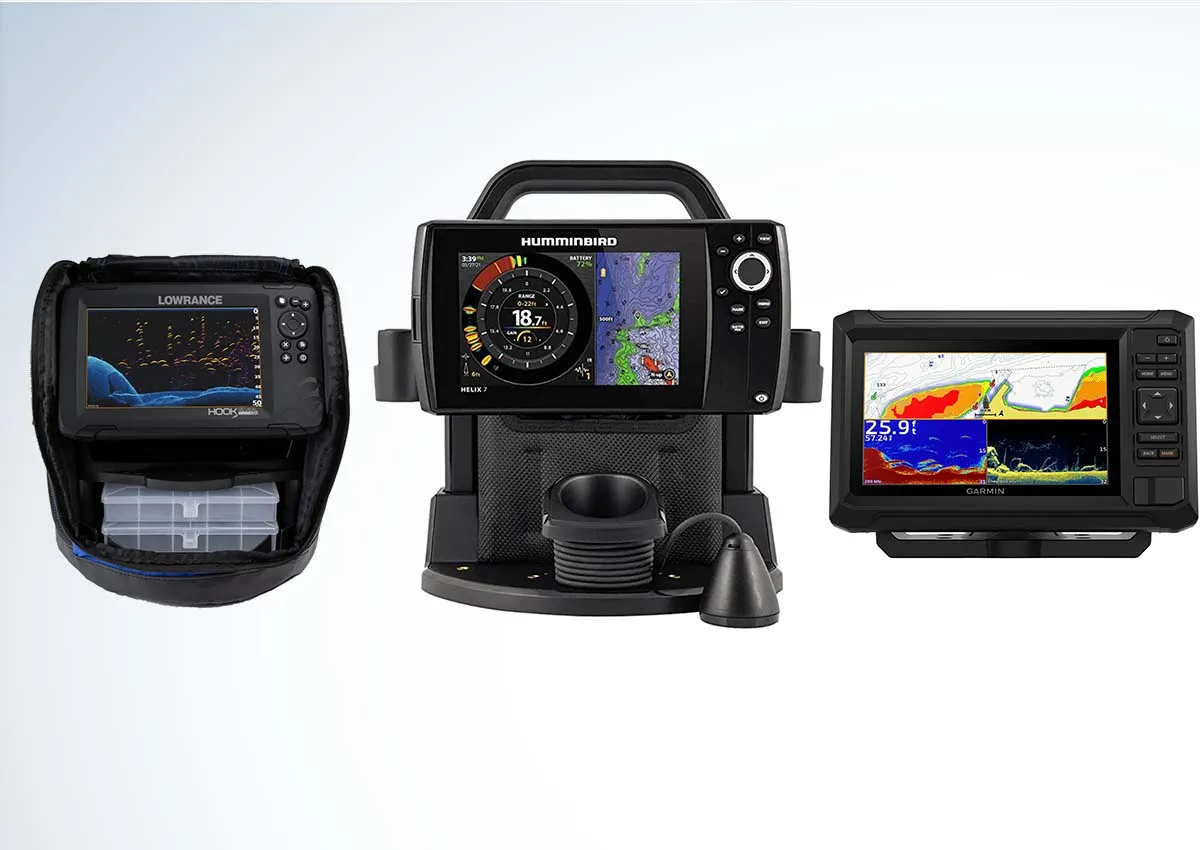
Depth Finder for Boat 2024: Essential Guide to Top Models

Catamaran vs Yacht

When getting into sailing, there are so many types of boats you can choose from—pontoons, tritoons, catamarans, yachts, sailboats, fishing boats, deck boats—and all of them have different advantages and disadvantages when getting out into the water. But when it comes to a catamaran or a yacht, which is better, and what are the costs to calling one your own?
Table of Contents
What is a catamaran?
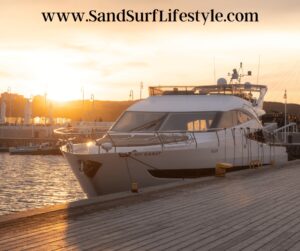
Catamarans come from the peoples of the Indian and Pacific Oceans, who used this form of boat to expand from island to island. The word itself is derived from the Tamil word “kattumaram” which means “logs bound together.”
Because of their construction, they usually have less hull volume, which means they have a shallower draft and a smaller displacement. They are also more hydrodynamic comparatively and require less power than another monohulled boat of the same size. The wide hull of the catamaran also reduces the likelihood that it will heel, or start to roll, in the wind. The wide stance also reduces the wake that the boat gives off.
It is possible to race with catamarans, especially if you are looking for both speed and stability overcapacity. Catamarans built for recreation and sport can be launched and landed from a beach and usually contain a crew of two.
What is a yacht?
A yacht is a blanket term for a boat that uses either sails or power for cruising, racing, or pleasure. While there is no real definition for a yacht, they are typically any sort of boat that has a cabin for overnight use and is a pleasure vessel over 30 feet in length.
There are different sizes of yachts under certain designations—any yacht over 79 feet is considered large, while any yacht over 131 feet is considered a superyacht or megayacht.
The word yacht comes from the Dutch language, which means “hunt.” It started as the name of the fast-sailing ships that the Dutch used to hunt for pirates in the 18th Century. The concept of pleasure boats, though, started early in the world’s history in Egyptian times and only increased in popularity as time went on.
There are several types of propulsion for yachts—sailing, which is when they use sails to catch the air and power. Yachts first started with steam power before turning to the internal combustion engine.
Most yachts, if large enough to accommodate, have a main salon and a forward stateroom in terms of cabins. The larger the yacht, the more rooms it may have.
Catamaran vs. Yacht: Structural Differences
If you are looking for a cruising catamaran, you will need a larger boat than the monohull counterparts. While a monohull can be small, usually around 30 feet, if you want the same sort of carrying capacity out of a catamaran, you will need a boat upwards of 40 feet.
Because of their larger size and width, catamarans will take up more space in your marina, but they are also more spacious than other boats—that width is not put to waste on the deck or underneath.
The double-hulled catamaran also gives more privacy when it comes to the living spaces—the cabins are conveniently separated, keeping the living quarters and sleeping quarters apart on most catamarans.
Looking to purchase a catamaran? Here are the pros and cons of owning one.
Catamaran vs. yacht: performance differences.
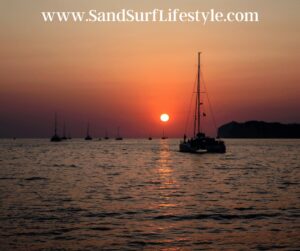
That speed, though, comes at a price—because they have two hulls, you will hear the water slapping against the boat from underneath, which is something you do not get with a monohulled boat.
Because they have two hulls, catamarans are nearly resistant to any sort of heeling, compared to a yacht. They also have extremely high resistance to capsizing, due to their multi-hulled construction. This stability allows for passengers to easily navigate the deck without fear of suffering from wave action. This stability will also let you cook and do any other activities on the deck without fear of displacement.
Catamarans are also easier to handle than another type of boat—one person can singlehandedly sail such a vessel. Because you have two engines and two rudders, it is easier to dock and maneuver compared to a monohulled boat.
Yachts tack much quicker than a catamaran as well—when you turn into the wind so you change which direction the wind blows on the ship—meaning your catamaran will slow down significantly as you turn. A monohull is more maneuverable in the wind.
Catamaran vs. Yacht: Cost Differences
A new, high-quality catamaran larger than 40 feet can run about half a million in cost. Pre-owned catamarans can run as low as $35,000, while larger, new catamarans can exceed $5 million.
Catamarans will also cost more because of the need for two engines and two rudders. The double hull means more equipment, which therefore increases the price. They also use different types of materials, making that cost increase. They also are typically higher quality construction and are safer and easy to sail, pushing the price higher. Because of this equipment increase, your service costs will also be higher.
If you are looking for a smaller yacht, those would put you within the 50 to 70 feet range. Choices also include the engine and optional equipment, along with whether you intend to purchase a new or a pre-owned yacht. New yachts in this size range can run about
Pre-owned yachts of this size can run anywhere between $300,000 for a smaller model to almost $6 million for a larger one. Most around 50 feet are an average of $375,000.
Catamaran vs. Yacht: Which is better?
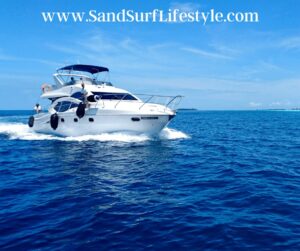
If you want to stay with the traditional sailing experience with more feedback about how your ship is moving, along with keeping a smaller footprint both on the water and in the marina, a yacht is the way to go. They are much more maneuverable than a catamaran in the water. Yachts are also cheaper than a catamaran.
Regardless of what you’re looking for in a boat, the choice remains with you about what you value most in your travels. Whether it’s a catamaran, a yacht, or something entirely different, know what you are looking for in your vessel before going out and looking to buy.
Please note: This blog post is for educational purposes only and does not constitute legal or medical advice. Please consult a legal expert or medical professional to address your specific needs.
Aloha! My name is Shawn and I Love the Beach and Ocean! From surfing to beach sports to boating and fishing I like it all. More importantly, I Love the people I get to meet who also share a passion for the sand and surf. Living and growing up near the ocean my heart has always been connected to the beach and its lifestyle. I wish to share my experience with those around the world. Mahalo (Thank You) for visiting and enjoy your stay here on my site!
Recent Posts
Adaptive Surfing: Overcoming Challenges and Inspiring Stories
Adaptive surfing has truly opened my eyes to the power of resilience and determination. The sport's inclusive nature has broadened my perspective and highlighted how adaptive surfers face and...
Spotlight on Surfing Destinations: Hawaii Edition
Exploring Hawaii's Surfing ParadiseSurfing in Hawaii has been a dream come true for me, as it's where I've discovered some of the most incredible waves and surfing cultures in the world. In this...
Catamaran Vs Yacht
Learn the difference between a catamaran vs yacht charter, what yacht should you charter catamaran vs monohull, what is better to charter a catamaran vs yacht.
Those new to yacht charter and catamaran charter will often ask, what is Better to charter – a Catamaran or Yacht? To assess the catamaran vs yacht question, we need to understand the main differences. A catamaran is, strictly speaking, a yacht with two hulls and a yacht in this context and a sailing vessel with one hull, otherwise known as a monohull.
It’s easily arguable that a sailing yacht was more fun to sail, takes up less room when mooring, and is cheaper per berth than a catamaran. Alternatively, a more stable catamaran offers more space and is cheaper per sq. foot of space.
Until recently, the advent of catamarans in the America’s Cup competitions would show that catamarans are not the slowcoaches they were when you consider the c atamaran vs yacht debate. All catamarans are very nice to sail just off the wind, which will leave some saying that my characterisation is a little skewed. Yet, I would say, in general, for charter catamarans vs charter yachts, the comparison holds.
Your Answer Will Depend on Many Different Variables Such as:
- Advantages of Catamaran Vs Yacht
- Disadvantages of Catamaran Vs Yacht
- Getting Into The Detail
- Thoughts on a Monohull Charter
- How to Book
Here are our 5 Reasons to Hire a Catamaran Vs Yacht
The Pros of a Catamaran Vs Yacht
The 5 reasons to hire a catamaran versus a yacht.
- Space. When weighing the Catamaran Vs Yacht debate, space is one of the key factors by far, but you’ll also see this appoear in our list of disadvantages too. In terms of squarefootage, if you like to pack generaously, or have planty of space for sunbathing, then Catamarans vs Yacht is for you.
- Cabins. Along the same theme, Cabins are generally much more spacious than monohulls. The locker storage space is always much greater than that of a monohull. The greatest advantage is the considerably larger ports (windows), which, when sailing in August, not only gives you a great view but comes in super handy to let in the breeze.
- Stability. Catamarans are notoriously more stable than that their counterpart. This can be beneficial for new or inexperienced sailors who haven’t got their sea legs yet or are prone to seasickness. Due to their two hull design, cats do not heel over more than 5 degrees. This means you don’t have to check that plates are not sliding off the table continuously!
- Draft. Catamaran’s shallow draft (depth of the hull and keel under the water) has some advantages. This is a particular advantage in areas with shallow waters, thus allowing you to anchor closer to shore.
- Power. Catamarans have twin engines. This, combined with the shallow draft, allows the yacht to cruise at higher speeds, whether under sail or using its engines. The two engines also allow greater manoeuvrability in confined areas or spaces, great in marinas or when picking up mooring buoys.
The Cons of Catamaran Vs Yacht
Four things you might want to consider with a catamaran vs yacht.
- Mooring . Due to the width (and size) of a catamaran, often, you have to pay a lot more to book a berth in a harbour for the night. However, some authors can be quoted as saying that anchoring in a cat is easier.
- Upwind Sailing. Catamarans don’t sail up-wind well! Performance cats make up for this with boat speed and by employing daggerboards to prevent leeway (sideways movement). It will be fun trying to sail upwind, but you might not make much progress!
- Steering. Sailors have noted that the helm (be it the tiller or a wheel) is not as responsive as a monohull, you don’t get the same feedback (weather helm) on a cat, and it can feel ‘limp’ to sail.
- The Feel. Most charter cats are built for comfort, so the sailing can be a little disappointing unless you’re on a beam reach.
The Pros of a Yacht vs Catamaran
Getting into the detaila - monohull vs catamaran advantages.
Monohulls offer the ultimate sailing experience for many sailors. Here’s why:
- Dynamic. When considering a monohull vs catamaran, remember monohulls can tack quickly, thus making them a lot more manoeuvrable than a cat. Nothing beats the rhythmic feeling of sailing whilst heeling over.
- Responsive. They are also fairly responsive to the helm.
- Up-Wind. These vessels are much more capable up-wind than most catamarans. They can sail much closer angle to the wind than a cat.
- Budget. Monohulls are cheaper to buy (fewer materials) than catamarans, often aimed at the luxury market and significantly less to charter. Berth for berth, cabin for cabin, a monohull is usually better value for money.
- Berthing costs. With twin engines, expect to put a little more fuel in your cat. The cost of berthing in a harbour or at a marina tends to be significantly lower due to the reduced beam (width).
The Last Case for a Monohull!
There are good reasons to consider a catamaran vs yacht, but if you love being up close and personal with your crew and you love dynamic sailing, here’s the big advantages.
- Snug. Modern charter monohulls are wide with high ceilings and have plenty of space in cabins and for stowage. That said, the usable space on a monohull is much less than that of a catamaran.
- Heeling. The boat heeling or “leaning” over is perfectly normal and something you get used to quickly. This can be tricky for the young and old and makes handling the boat a little more adventurous.
- Draft. Due to the deeper keel (the stabilising fin below the yacht), you cannot sail in shallow waters and must be more vigilant of your depth.
Learn More About Chartering a Catamaran Vs Monohull
As you can see, there are many pros and cons to consider when deciding between a catamaran vs yacht. Whilst the debate between monohull sailors and multi-hull fanatics will rage, it largely depends on what you are using the boat for, where, your budget, and your crew.
If you have the opportunity to decide if you prefer a catamaran vs monohull, by sailing both types of boats, then take it so you can assess the benefits of both wonderful sailing boats.
If you are planning a sailing trip and are a little unsure, why not get in touch, and we can help you decide what is best for your location and crew.
Amazing Sailing Experiences
Our amazing customers.
I didn't think sailing with my family would be so much fun...
Sailing for the first time.

Everything went smooth, the paper processing, special requests and the specs of tht check-in procedure. Boat was also in good shape, so no complaints and a worry free holiday...
We had a great experience with booking through sailchecker.
Informative and looked for the best value for our family. Very good customer service on this side and in Greece. Great boat and skipper...
Fantastic holiday from start to finish.
They were very responsive and very quick to answer questions via email and instant chat. They had extensive knowledge of the area...
We will most definitely use their services for our next bareboat sailing vacation.

Sailchecker were professional from start to finish - and were awesome dealing with a problem! Our first Yacht had serious issues and sail checker helped us to resolve it...
They are easy to deal with, straightforward and honest and I would recommend them to anyone planning a charter holiday.

During the Coronavirus pandemic, Kate and her colleagues at Sailchecker have performed brilliantly. They have been considerate and highly efficient in re-organising our Turkey charter and also provided lots of assistance in getting our Yacht Security Deposit insurance policy transferred to match our revised charter dates.
Truly worthy of a 5 star rating!

Would I go sailing again? OMG yes! Sailing is the perfect family holiday. Boys loved the activities, I enjoy relaxing as well...
Sailchecker.com arranged a sailing cruise her family of 2 sons, daughter & hubby in the BVI with their own.

It was sail in the day… party at night. We couldn't have wanted a better skipper or a Spring Break! Good times...
Arranged for 6 friends to sail Spring Break in the British Virgin Islands for under $500 each.

All bookings and confirmations was always accurate with no delays. Our boat was also fabulously maintained and the Skipper new the area extremely well...
Everything was down to the tee.

Rated 4.9 out of 5 based on 215 reviews on Trustpilot
Got a Burning Question About Catamaran Vs Yacht?
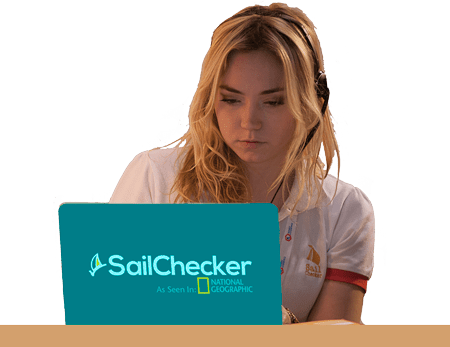
Founder Member IFCYA
Yacht Charter & Sailing.

Start typing and press Enter to search

What Is the Difference between a Catamaran and a Yacht?
A catamaran and a yacht are two types of boats that can be used for either recreational or commercial purposes. The word yacht is derived from Jacht, the Dutch word for hunt, because the first yachts were high-speed boats that were used as patrol boats by the Dutch Navy. In Malaysia, people use the word kattamaram to describe a boat with two hulls, and Tamil people in Sri Lanka have traditionally used the word kattumaram to describe the same type of vessel. The word catamaran is an Anglicized version of these variants of the same name.
King Charles II of England used a Dutch yacht to return to his kingdom when the crown was restored in 1658. Having been given two yachts as a gift from the Dutch government, King Charles II commissioned the construction of a fleet of 24 more yachts shortly after his return. Thereafter, yacht racing developed as a popular past time among aristocrats in the British Isles. The first known catamarans were used by the Greeks between 300 and 200 B.C., but similar boats were also used by Polynesians and Tamils. Catamarans first came to Western Europe in 1662, when an English sailor named William Petty constructed one.
A catamaran and a yacht have certain similarities. Both are used for racing because both types of craft allow for easy maneuverability. Catamarans have two hulls that are connected, making these crafts less likely to capsize than yachts, which have just one hull. A catamaran has a faster average speed than a yacht, but the lightweight structure means that they are more difficult to turn than yachts.
Sails or engines can be used to propel both a catamaran and a yacht. For racing purposes, sales are normally used. Vessels that are used as commercial passenger boats tend to be operated by engines. Yachts are broken down into groups based on size, and day sailing yachts are the smallest, followed by weekender yachts, cruising yachts, and luxury yachts. Some people refer to catamarans as two-hull yachts, and three-hulled yachts are also being developed.
Sailing yachts are normally between six meters and 30 meters (19.69 to 98.43 feet) in length. Larger but similar types of vessels are commonly referred to as ships. No size limits apply to catamarans, although most are similarly sized to yachts. Both a catamaran and a yacht can be used as a passenger vessel, and some boat construction firms have developed mega yachts and catamarans that can carry significant numbers of passengers over large distances.

- Find A School
- Certifications
- North U Sail Trim
- Inside Sailing with Peter Isler
- Docking Made Easy
- Study Quizzes
- Bite-sized Lessons
- Fun Quizzes
- Sailing Challenge

Catamaran Sailing – What’s the Difference?
By: American Sailing Sailboats
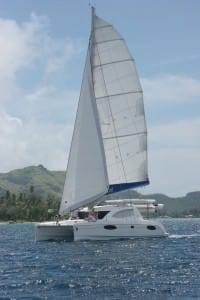
What is a Catamaran?
A traditional sailboat is a monohull–in other words, it has only one hull centered around a heavy keel. A catamaran is balanced on two hulls, with the sails in the middle. It’s as simple as that. Depending on the size of the boat, the space separating the two hulls might be filled by a cockpit, a main cabin, and usually some netting (which can be a great place for relaxing in the sun). Why are Catamarans Popular?

In response to their rise in popularity, ASA developed 114: Cruising Catamaran . This course is ideal for people who already have monohull cruising experience and want to translate that over to the catamaran. You’ll learn all the advantages and disadvantages of multihull sailing so that you’ll always be making an informed decision when considering which boat to charter or buy. You’ll also get the practical sailing skills you need to be confident and have a great time on your cat. Contact an ASA school near you to see if they offer ASA 114: Cruising Catamaran.

- Charter Resources
- Your First Charter Sailing Vacation Today bareboat chartering is the culmination of your sailing education. When you walk across the deck and get your sailing diploma you step on to the metaphorical boat of your future and you can sail it anywhere you want!
- Charter Sailboat Resources Whether you have just begun to sail and have recently earned your ASA 101 certification or if you have already mastered ASA 114 and are a veteran of bareboat charters this resource should help you.
- Bareboat Charter in the BVI Getting aboard your bareboat charter is the goal when you get your ASA sailing certifications. Where do you begin? For many, it is a sailing vacation in the British Virgin Islands.
- Choosing a Charter Boat Company It’s time for you to set off on your own and explore endless shorelines and secluded coves. You have mapped out your plan and you have reserved your vacation time now all you need is a boat. How do you choose a charter company to rent a boat for a week?
- Choosing The Right Boat for Your Sailing Charter When you decide to take a sailing vacation aboard a sailing vessel that you will call home for a week or two you’ll be surprised by just how much you think you need.
- Sailing in Europe? Chartering overseas is on the bucket list of many a sailor, but making it happen comes with a stipulation or two. A sizable number of countries require an International Proficiency Certificate that lets them know the charterer is trained, qualified and prepared to take one of their boats out to sea.
Related Posts:

- Learn To Sail
- Mobile Apps
- Online Courses
- Upcoming Courses
- Sailor Resources
- ASA Log Book
- Bite Sized Lessons
- Knots Made Easy
- Catamaran Challenge
- Sailing Vacations
- Sailing Cruises
- International Proficiency Certificate
- Find A Charter
- All Articles
- Sailing Tips
- Sailing Terms
- Destinations
- Environmental
- Initiatives
- Instructor Resources
- Become An Instructor
- Become An ASA School
- Member / Instructor Login
- Affiliate Login
- Marine Supplies
- Maintenance & Boating Guides
Catamaran vs Monohull: Pros, Cons & Main Differences
By: B.J. Porter Editor

The choice of catamaran vs monohull ultimately comes down to preference. What’s critical for one buyer may mean little to another. If your partner refuses to set foot on a boat which heels, that’s a deal-breaker for a monohull. But if you’re passionate about classic looks and styling, your quest for beauty may override other considerations and rule out catamarans.
We can’t tell you whether a catamaran or a monohull is right for you. But we can help you with the pros and cons of each for your search.
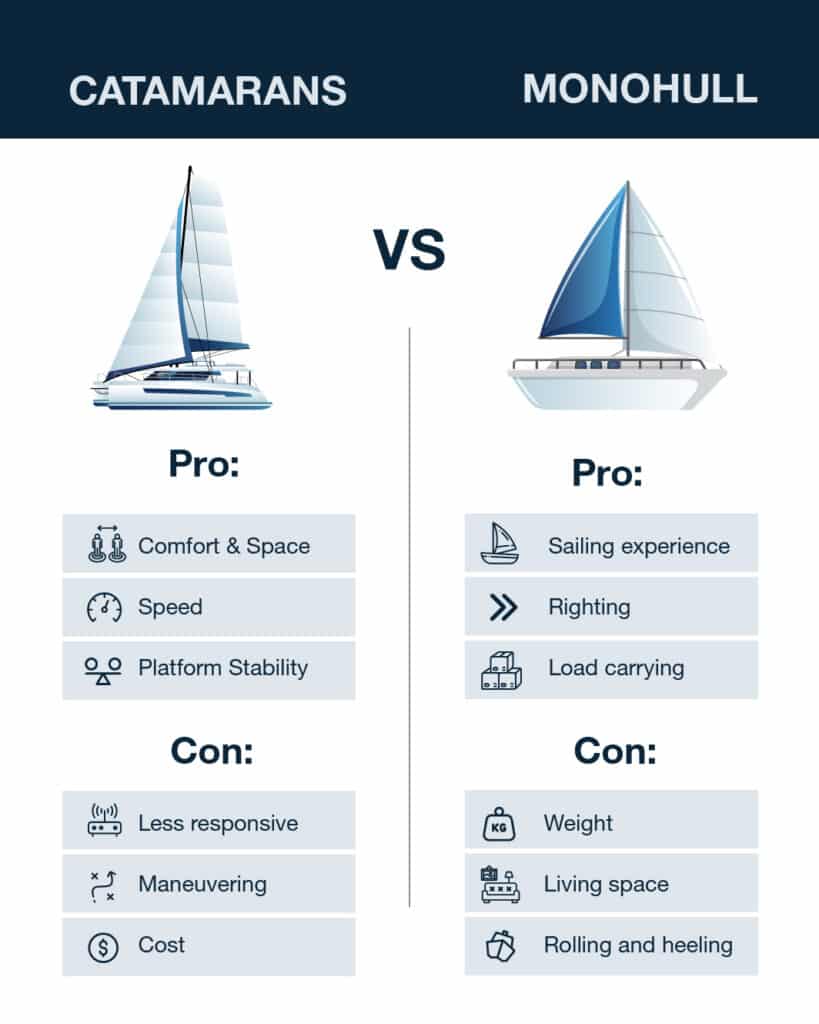
The Strengths and Pros
No matter your choice of monohull or catamaran, there are safe, comfortable, and excellent sailing boats of both types. Neither has an exclusive lock on any strength, and both sail safely and comfortably. But there’s a different emphasis on how they do it. No matter what you are trying to do – sail fast, cruise the world, or just host a crowd at the dock, there are monohulls and catamarans that can work for any requirement.
Catamaran advantages
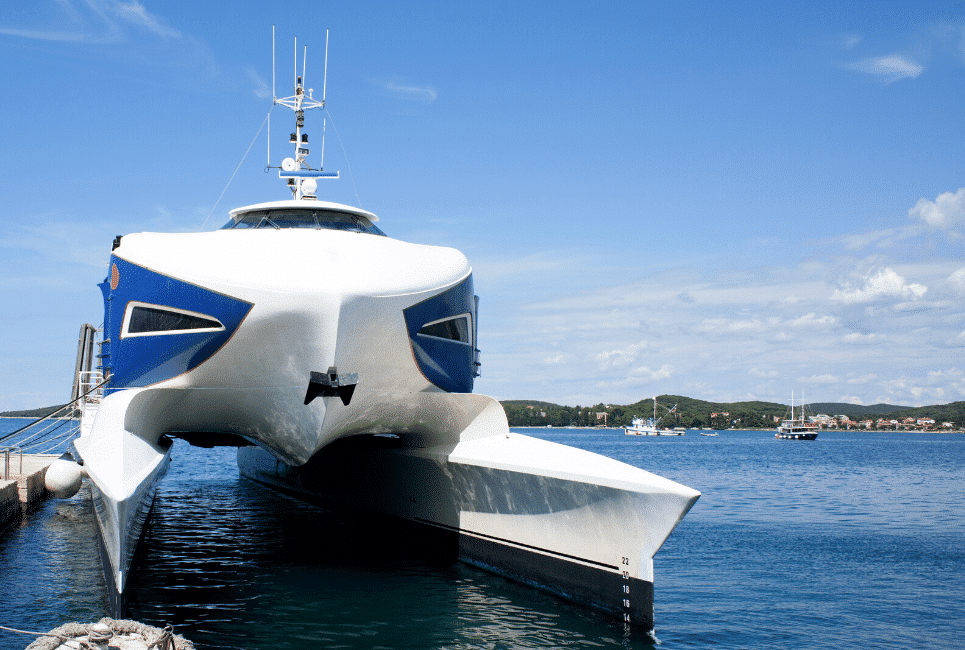
Space and comfort: Two hulls and a wide beam make a very stable platform with lots of volume in the saloon and cockpit. Most living space is above the waterline, with wonderful light and airflow. Cabins in the hulls offer better privacy and isolation, usually with standing headroom.
Straight line speed: Most catamarans are faster in straight-line sailing speed (1) that similar sized or even longer monohulls. Without a lead keel, they’re lighter, so more driving force from the sails converts to speed, and narrower hull forms may have less drag than wide hulls with deep keels. Some heavier cruising catamarans may not be faster, especially if they keep rig size small for ease of handling.
Stability : The beam of two hulls with a bridge deck leads to much higher stability and resistance to roll (2). Waves in an anchorage that induce violent roll in a monohull may make a catamaran bounce or bob. Under sail, catamarans do not heel appreciably even when powered up.
Twin engines. : With one engine in forward and balanced in reverse, most catamarans can spin in a circle in place and make sharp adjustments to the boat’s direction. If you have an engine failure, you also have a second engine, giving a safety edge when you can’t sail.
Monohull advantages

Upwind sailing performance: While catamarans have the edge at straight-line speed, monohulls sail closer to the wind. When you’re racing or you have to sail upwind to get to the next island, this can get you there faster.
Sailing feel and responsiveness : The “feel” of sailing a monohull is much better. With a single hull, you’ll feel wind pressure and trim adjustments immediately for a more responsive helm and a better ability to sail to the wind.
Maneuvering under sail: Monohulls are quite nimble tacking and turning under sail, and there’s less risk of slow or missed tacks.
Righting Moment: The primary offshore safety argument for monohulls is their ability to right when capsized. The heavy keel keeps the boat deck up when sailing, and most monohulls will come back upright even after a complete capsize.
Cargo and Loading: A higher displacement boat with thousands of pounds of lead hung from the bottom isn’t going to be as affected by loading as a relatively light multihull.
Aesthetics: This is subjective, as many catamaran enthusiasts love how they look. Classic sailboat styling, with swept sleek looks, springy sheer lines, and all the “right” proportions are more common on monohulls.
Also read: The 5 Best Electric Anchor Winches
Weaknesses and Cons
Like strengths, weaknesses are relative; just because one class has a strength doesn’t mean the other doesn’t. There are spacious monohulls and beautiful catamarans, just like there are cramped catamarans and unattractive monohulls. The differences have to be highlighted relative to each other, and the weaknesses of one are most apparent compared to the strengths of the other.
Catamaran Cons
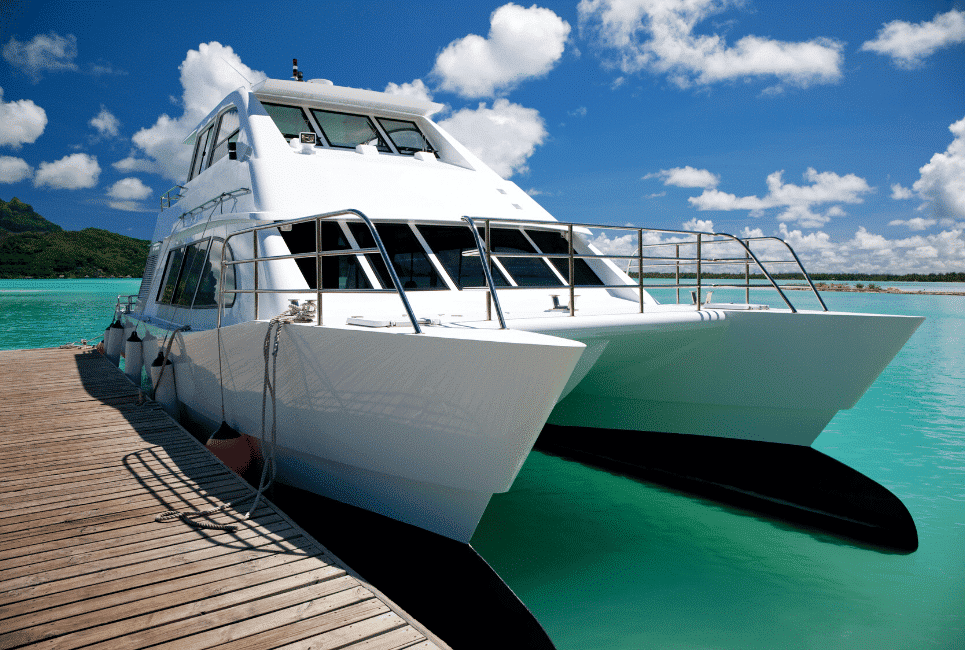
Upwind performance: Cats don’t sail as close to the wind, but they make up for it by sailing faster off the wind. You’ll sail a less direct course upwind. Even if you get in at the same time, you’ll have to sail farther.
Less responsive sailing: Two hulls with two rudders and a very broad platform reduce the helm feel when sailing, cutting responsiveness sailing in shifting wind and wave conditions. It also makes tacking slower.
No-flip zone: It is very difficult, but not impossible, to flip a large catamaran (3). But if a catamaran capsizes, it will not flip back over by itself.
Large in marina/close quarters: You have two problems in marinas. Beamy cats are tough to maneuver in tight spaces because they’re big and visibility is tough over the hulls. And many marinas charge extra because the wide beam extends into the next slip. The good news is that twin engines make tight maneuvering easier.
Price point: Catamarans are more difficult to build and need more materials. This is directly reflected in the cost of the boats.
Monohull Cons
They are heavier: Every large monohull needs a keel for stability (4). They can not sail or stay upright without thousands of pounds of ballast, and this makes them heavier and slows them down. Tiny monohulls can use a centerboard or daggerboard for stability, but most boats big enough to sleep on need ballast.
Darker interiors : Most monohull living space is lower in the boat, where you can’t put enormous windows for light and circulation. It’s very hard to get space as bright and airy as catamaran saloons.
Less living space: With one hull and no bridge deck saloon, most monohulls feel cramped compared to spacious catamarans.
More prone to rolling motions : Only one hull makes monohulls susceptible to rolling in waves, and the movement can be quite uncomfortable.
Heeling: Tipping is just part of sailing monohulls upwind and is unavoidable. It can be reduced on some other points of sail, but not eliminated. Many people, especially non-sailors and new sailors, find this movement uncomfortable or distressing.
You might also be interested in: How to Buff a Boat | A Detailed Guide by a Boating Expert

Troubleshooting Pontoon Boat Battery
Pontoon boats are a great way to enjoy the water and spend quality time with family and friends. But just like any other boat, they rely on a battery to power various systems, including navigation lights, trolling motors, and other…
Boat Accessories

Best Ice Fishing Fish Finders in 2023
In search of the best ice fishing fish finders in 2023? Not all fish finders are created equal, particularly when it comes to ice fishing. Specialized features are crucial to ensure successful outings in harsh winter conditions. You require a…

Best Side Imaging Fish Finders in 2023
Navigating the world of angling equipment can be challenging. That's especially true when it comes to side imaging fish finders, given the extensive range of options available in 2023. This post makes it easy for you to narrow down your…

How to Choose a Fishfinder for Your Boat: A Comprehensive Guide
Today, we embark on a journey to unravel the secrets of choosing the perfect fish finder for your boat. As we navigate through an ocean of options, we'll explore different types of fish finders, delve into their key features, and…
Accessories
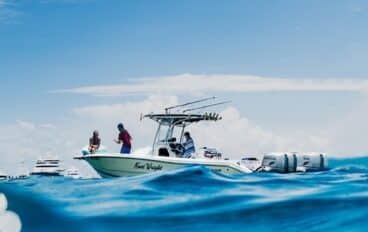
5 Best Portable Fish Finder in 2023
Looking for a portable fish finder for kayaking, ice fishing, or other activities? The good news is that there are a lot of solid products out there. The year 2023 has ushered in an array of advanced models, each brimming…
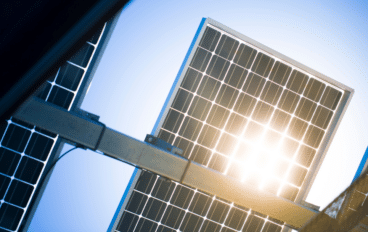
Charging Your Trolling Motor Battery with a Solar Panel
Charging your trolling motor battery with a solar panel is not just the right thing to do for the environment, it is extremely convenient. When you’re out on the boat, with any luck, you’ll have access to a good amount…
Don't miss out
- First time on a catamaran: what you need to know
During your captain training, you'll have learnt how to manoeuvre a monohull sailboat . But what about when you have the opportunity to sail a catamaran? Find out everything you need to know, including differences from monohulls, important factors to consider, pros and cons, and recommended destinations and catamaran models. If you're new to catamaran sailing, this is the perfect guide for you.
5 reasons to rent a catamaran
What are the main reasons why someone decides to sail on a catamaran? Here are the top benefits of choosing this type of boat.
1. Stability
The double hulls of a catamaran provide exceptional initial stability, allowing it to remain afloat and stable in rough waters and wind. If you're looking for a smooth and peaceful sailing experience, especially with small children or seasickness-prone individuals, a catamaran is a great option. It's perfect for taking along your grandma or a nervous friend who's never been on a boat before.
YACHTING.COM TIP: Getting seasick is not only a major worry for novice sailors, but also holidaymakers on a boat trip. But it even can affect experienced sailors from time to time. Those with darker humour say it has two phases — in the first phase you become so sick you're afraid you're dying, and in the second, you're afraid you're not going to. The important thing, though, is to understand why it happens and try to prevent it. Although you'll significantly reduce suffering from seasickness on a catamaran, what works best if it does occur? Find out in our guide — How to cope with seasickness .
A catamaran offers more space than any other boat of similar length. With spacious saloons , plenty of seating and lounging areas , and ample sunbathing spots (such as the netting known as the trampoline ), you'll never feel cramped. The cabins are roomy and the bathrooms are as big as those in many apartments. People who dislike tight spaces or value their privacy will find a catamaran ideal. On larger models (50+ feet), you'll have so much space, you may have trouble finding each other. Despite its comparable length, a catamaran always feels larger than its monohull counterpart. If you're used to a 50-foot sailboat, try a 45-foot catamaran and you'll still feel like you have more space.
3. Amenities comparable to a hotel room
Not only are the cabins spacious, but they are also comfortable and cosy. They usually come equipped with high-quality bedding, pillows, shelves, reading lamps, and more, making them feel like a proper room. That's why we wrote an article highlighting 9 reasons why a sailing holiday is better than staying at a hotel and it's doubly true with a catamaran.
4. Added extras
Catamarans often come equipped with the latest technology and gadgets. These include solar panels, generator, a seawater desalinator, a modern plotter with GPS, and autopilot . These will make you more self-sufficient at sea without needing the facilities of a marina as often.
5. Shallow draft
The reason why catamarans are so popular with sailors, especially in exotic countries , is the very shallow draft — 0.9 to 1.5 metres, depending on the length of the vessel, which means skippers don't have to concern themselves so much about hitting the seabed. While caution and monitoring charts are still necessary, it provides greater freedom in choosing anchorage spots, allowing you to sail almost right up to the beach and anchor to enjoy the peace and tranquillity.
Only small fishing boats can get as close to the shore as catamarans.
Check out articles about other boats and boating gear
Catamaran vs. sailboat: the main differences.
Sailors have differing preferences, with some sticking to single-hulled boats and others preferring catamarans. In fact, which is best has been a hot topic since sailing began. This makes understanding the benefits and drawbacks of each hull design essential so you can make your own choice.
1. Rental price
One major drawback of catamarans is their higher cost on the charter market. Single-hull sailboats can be rented for 1,000-2,500 euros per week, while a well-maintained catamaran typically starts at 3,000 euros per week. However, this may not be the case for all models.
YACHTING.COM TIP: If you want to save money on your catamaran charter, we recommend booking it in advance. Check out our 8 reasons why Early Bird deals are the best way to rent a boat .
2. Capacity
The higher cost of catamaran charters is offset by the extra space, comfort, and capacity — it can often hold up to 12 guests comfortably. This results in a per-person cost comparable to sailboats and cheaper than coastal hotels, making them popular for island cruising and party boats. However, for a safe and responsible party experience, we recommend checking out our guide — How to enjoy a party on a boat: 10 tips to keep your crew and your boat safe .
YACHTING.COM TIP: Never exceed the maximum capacity of the boat. And remember that even small children count as crew members.
A large crew can comfortably sail on a catamaran
3. Port charges and marina fees
Keep in mind that having two hulls means a wider boat, leading to higher docking fees . This increased width can take up more space than two smaller sailboats. However, the cost per person can be offset by the fact that more people can be accommodated.
4. Speed vs. consumption
Catamarans typically feature two high-powered engines , making them faster than similar-sized sailboats. Even without the power of the wind, you can be flying across the waters and with a better fuel efficiency than motor boats.
Catamarans typically have two basic sails: the mainsail and the foresail and operating them follow similar principles as on single-hulled sailboats. Self-tacking jibs can also be used, reducing the work required to trim and manoeuvre the sails.
For those looking to enhance their sailing experience, a gennaker can often be rented with the catamaran, providing added benefits, especially in light wind conditions. Take a look at our 5 reasons to rent a gennaker .
6. Flybridge
This elevated deck is a common feature on catamarans. Here you'll find the helm station and sometimes additional seating or lounging space. It is a valuable addition that provides extra living space on the boat.
The catamaran's second deck provides another spot to sit and enjoy views of the ocean
Who is the catamaran suitable for?
Catamarans are the preferred choice for a group of friends wanting a laid-back holiday on the water but are also popular for corporate team-building events and specialised stays like yoga. As their spacious deck provides a safe play area for children , they are also ideal for multi-family vacations.
YACHTING.COM TIP: If you are sailing with small children, safety is paramount. So, check out our guidelines for safe boating with kids , our article on how to survive on a boat with kids , the Skipper mom logbook: sailing with a baby and always try to stick to the 4 essential tips for smooth sailing with kids . If you don't have kids or don't want to bring them along, why not take your four-legged friend? Catamarans offer ample space for dogs to run around, and following these 7 tips can help make your pet a true sea dog.
On the other hand, we wouldn't suggest a catamaran to sporty sailors to chase the wind in, as the catamarans for charter aren't intended for racing or regattas. Due to their design, they have limited upwind capabilities (sailing boats can sail up to 30° wind angle, while charter catamarans can only handle up to 50° to 60° wind angle), making them unsuitable for competitive sailing.
YACHTING.COM TIP: If you have doubts about your ability to safely operate the boat, consider hiring a skipper. We can arrange a skipper for you who is knowledgeable about the area and can take care of the navigation for you or teach you any sailing skills you may be lacking. Remember when planning that the skipper will occupy one cabin or berth in the saloon.
Specifics of sailing on a catamaran
The principles of sailing a catamaran are similar to those of a monohull sailboat, but there are some differences to keep in mind. These may have already been covered in your captain's training course.
Travelling on the engine
A catamaran has two motors , each of which can be controlled separately using its own throttle control. Want to turn on the spot? That's no problem at all with a catamaran — simply add throttle with one motor and reverse with the other. Once you get the hang of this trick, you'll no longer need a bow thruster, although catamarans are sometimes equipped with one. This makes docking your catamaran a breeze compared to single-hulled sailboats.
Travelling on the sails
Sailing varies mainly in what courses you can sail and how strong the winds are. Most charter catamarans perform best on courses at 50 to 60 degrees to the wind. This is a greater angle compared to sailboats. So be prepared to have to adjust your planned route.
If you sail a sailboat too hard, the boat itself will tell you that you've over-steered by heeling. A catamaran won't do that, so you have to be very attentive to when to reef the sails. Usually, you will put in the first reef at a wind speed of 18 to 20 knots and the second reef at 23 to 25 knots.
Best destinations for catamaran sailing
In addition to the more traditional locations of Croatia , Greece , Italy , Spain and Turkey , we rent catamarans all over the world. In these destinations, you appreciate plenty of space , comfortable access to the water via steps, stability on the waves and amenities such as a barbecue and air conditioning .
However, catamarans are perfectly suited for more exotic destinations . In remote locations, the low draft comes in particularly handy as the seafloor is often poorly charted and the beaches are stunning. The large water and diesel tanks, along with an electricity generator, a desalinator to produce fresh water from seawater, and solar panels are especially useful in exotic locations where the yachting infrastructure is less developed. These features help sailors to be self-sufficient and avoid the need to find a dock every few days.
Popular destinations for catamaran sailing include the beautiful Seychelles , Thailand , French Polynesia and the Caribbean (Grenada, St. Lucia, Martinique, Antigua, St. Martin, Cuba , British Virgin Islands, Bahamas, and Belize).
YACHTING.COM TIP: Don't be apprehensive about sailing to more tropical destinations! Check out our guide to exotic sailing holidays . If you are headed to these warmer climes, you will need to find out when the rainy season or the hurricane season starts.
Views in the Caribbean are picture perfect
The most popular catamarans
Popular charter catamaran brands include Lagoon , Bali , Fountaine Pajot , Nautitech , and Leopard . These are the models that have received positive feedback from our clients for years and that we confidently recommend.
The Lagoon 380 offers a true sailing experience, or the larger Lagoon 46 , where you may end up spending the whole morning lounging in its spacious cabin.
The Bali cat space provides amazing seating up at the helm.
The Fountaine Pajot Elba 45 where you'll enjoy relaxing at the bow on the seating or the trampoline.
The Nautitech 46 with its huge saloon.
The Leopard 45 with its gorgeous bright interior, or the Leopard 50 that's so luxurious, you'll feel like a king.
YACHTING.COM TIP: For the discerning sailor, the Lagoon 620 and Dream 60 large catamarans are also worth mentioning. However, it's important to note that most captain's licenses are not valid for these giants and you'll need to hire a professional skipper.
Special types of catamarans
Catamarans have been around for quite some time, leading shipyards to continuously innovate and create new models with unique features and characteristics. So, what are some of them?
Power catamaran
The popularity of power catamarans has been increasing lately due to the fact that they provide the stability and spaciousness of a catamaran without the need to handle sails.
Do you believe that more is always better? Not satisfied with just two hulls? Then we have a unique chance for you to rent a trimaran , a three-hulled catamaran that offers an unparalleled sailing experience. Trimarans are still rare, so you're sure to attract attention wherever you go.
All catamarans in our offer:
Not sure if you want a catamaran or a sailboat no problem, we'll be happy to assist you in finding the perfect vessel. just let us know..

Denisa Kliner Nguyenová
Faq sailing on a catamaran.
What are the main differences between a sailboat and a catamaran?
- Number of hulls = stability
- More space = higher passenger capacity
- Higher charter and port charges
- Speed per engine
- Yachts for Sale
- Sales Report 2024
- FAQ – Luxury Crewed Yacht Charters
- FAQ – Bareboat charters
- FAQ – Sell your Boat
- FAQ – Buying a Yacht
- How Much does it Cost to Charter a Luxury Yacht?
- All Blog Posts and News
- Yachting for beginners
- Indian Ocean
- Mediterranean
- Sales & New build
- Motor Yacht
- Event & News

Trimaran vs Catamaran: What are the Differences?
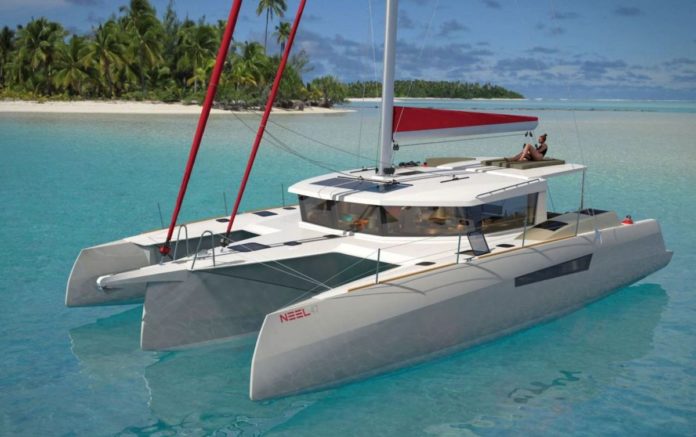
The debate between trimarans and catamarans has been raging for years, with no clear victor in sight. Despite their long-standing popularity as cruising vessels, trimarans have seen a resurgence recently – but what sets them apart from catamarans? The subtle differences lie mainly within the hulls; while monohulls are distinguishable several yards away, distilling one multihull from another requires closer examination of characteristics such as living space size accommodations, seaworthiness ratings , speeds achieved on test runs.
With these variables to consider – along with personal preference – deciding which vessel is right may be difficult indeed!
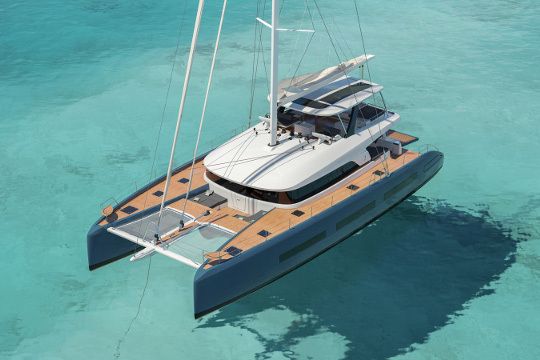
Performance and Stability: two distinct sailing experiences
The stability of a catamaran vs a trimaran.
When sailing on a monohull in strong winds, the boat can potentially capsize due to its single hull and lack of floatation. On the other hand, multihulls such as catamarans are more buoyant because they have two floats that help prevent immersion; however it still may be uncomfortable when navigating heavy seas. For the most optimal sail experience with great stability even through rough waters–pleasure trimarans provide an ideal combination! Three connected hubs act like small wheels over rippling waves while providing excellent comfort aboard no matter what conditions lie ahead!
Read also : Trimaran our ultimate guide
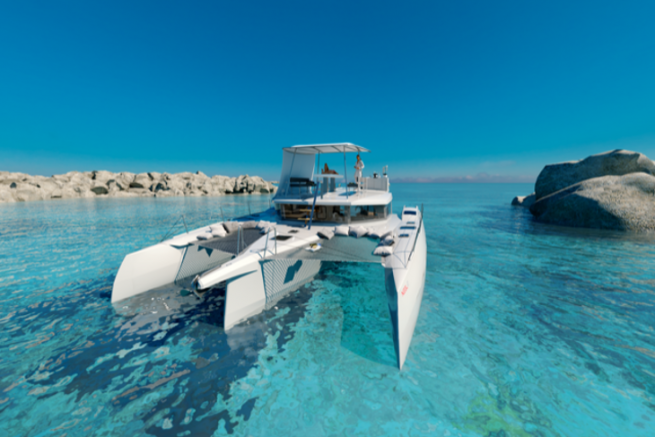
The wind and its influence on the performance of multihulls
In sailing, trimarans outperform catamarans in a headwind situation. Their unique hull design features both daggerboards and central weight focus which allows them to counteract the thrust of wind better so as to stay on course rather than drifting away like their counterparts do. This subtle difference makes significantly more efficient vessels resulting in overall faster speeds when heading into the wind – making trimiras an ideal choice for less experienced sailors seeking reliable performance!

Looking beyond traditional catamaran styles?
Trimarans such as DragonFly boast amazing features thanks to its “Swing Wing” system while Rapido Trimaran offers “an experience like nothing else”—thanks in part due to Morrelli & Melvin architect firm constructing this Vietnam built masterpiece!
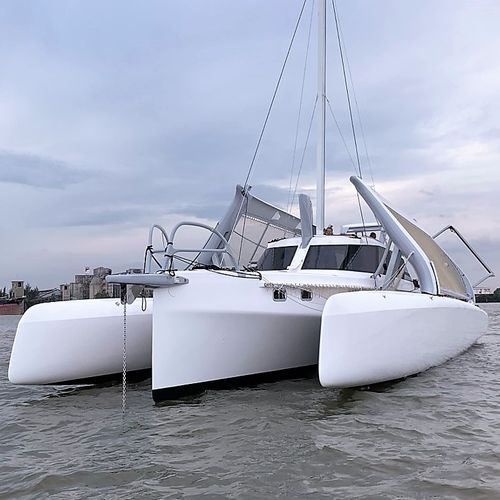
For those seeking a luxurious floating lifestyle, the trimarans from shipyard NEEL are second to none! These vessels feature ‘Cockloon®’ areas which seamlessly connect saloons and cockpits – providing uninterrupted living spaces with breathtaking panoramic views. Alongside this is an expansive flybridge offering extra room along with comfortable cabins nestled within their own designated floats for ultimate relaxation. You could say that these modern marvels of engineering provide all you need in one single package – now it’s just down to choosing your destination!
Looking for the perfect blend of stability, comfort and interior space? Look no further than the NEEL 65 – a unique trimaran that boasts roomy cabins thanks to its enlarged volume. Not only does it offer more living area compared with typical catamarans – but also features an optimally aligned central hull which provides extra safety at anchor! So if you’ve been in two minds between these nautical vessels; perhaps this could sway your decision once and for all…
Trimaran vs catamaran safety: the width of trimarans makes them safer
The trimaran stands out as the most secure of its multihull contemporaries. Its superior design consisting of three hulls, effective anti-drift strategies and centre-mounted weights combine to provide it with a groundbreaking 27° righting moment – allowing for excellent stability in even gusty weather or choppy waters. In comparison, catamarans offer just 12° degrees protection against capsize – meaning that the trustworthiness offered by a trimaran is hard to match! Further punctuating this remarkable level of security are features such as buoyancy tanks which ensure that if capsizing does occur, sinking will not be an issue: making trimarans perfect vessels for sailing’s safety conscious connoisseurs.
Racing trimarans
In the last decade, trimarans have surged in popularity for racing purposes due to their enhanced speed and safety capabilities. Their stability on rough seas allows them to be pushed further than catamarans can go without sacrificing control of the vessel; this is why most multihull races since 2010 have been captured by a trimaran! The Jules Verne Trophy has not seen any different – all winners since its start in 2010 are proud owners of these three-hulled vessels.
How to make the right choice between a monohull, a catamaran, and a trimaran?
No matter what sailing adventure you have in mind and the destination, it is essential to select a vessel that will fulfill your dreams while meeting all of your demands. Make sure to pick wisely!
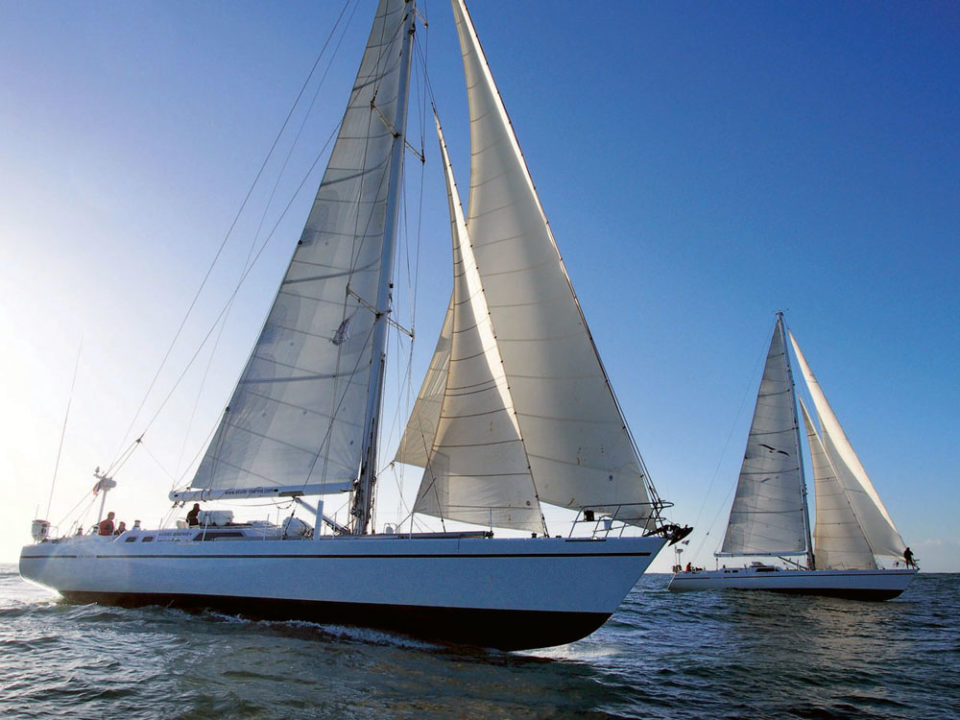
Choose a monohull sailboat if you like sailing!
Nothing quite compares to the feel and freedom of a sailing adventure aboard your own monohull sailboat. With its large, retractable keel, you can explore shallow waters where other boats may not venture while taking in stunning vistas from beyond the coastline. Enjoy an unforgettable experience with every rustle of wind across your sails!
Read also : Monohull vs Catamaran, which one to choose?
Pick a catamaran if you like volume and calm seas
TThe catamaran is perfect for adventurers seeking the tranquility of sailing with family and friends. With a spacious interior, multiple cabins equipped with bathrooms, and an enviable amount of storage capacity above 12m in length – it’s easy to see why these boats have become so popular! However when navigating more turbulent seas keep in mind that their windward grip may make maneuvering tricky; but Catana’s boat selection has you covered thanks to its range featuring daggerboards allowing captains ultimate control over any situation.
Pick a trimaran for a good combination of volume and performances
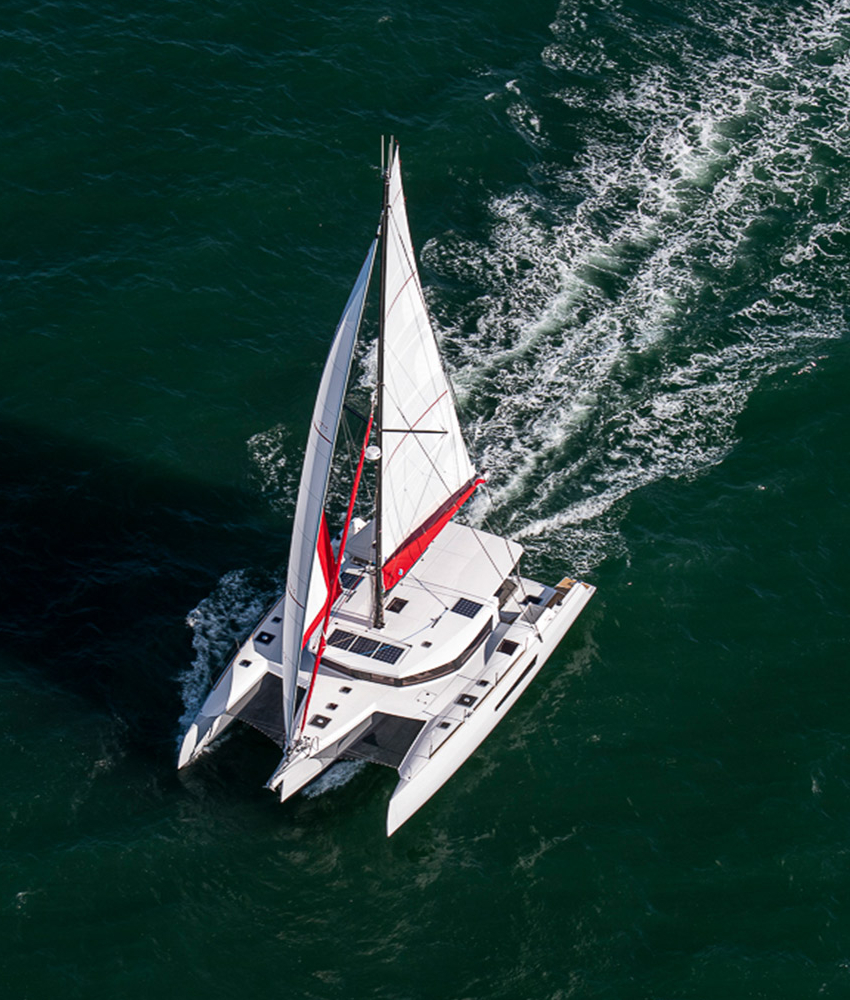
For those looking for a sailing experience like no other, trimarans are the perfect answer. They offer lightning-fast speeds and truly exhilarating performances on open waters – all while providing plenty of roomy living space comparable to catamarans of similar size! Whether you’re attempting an adventurous transatlantic crossing or simply want to enjoy some pleasant cruising around the world, selecting a recreational trimaran could be your best bet.
Enjoy cruising on the NEEL 51 , a unique charter yacht that offers plenty of space without sacrificing performance. This trimaran-inspired vessel is perfect for travelers who want to explore new destinations quickly and safely — with speeds twice as high as other options!
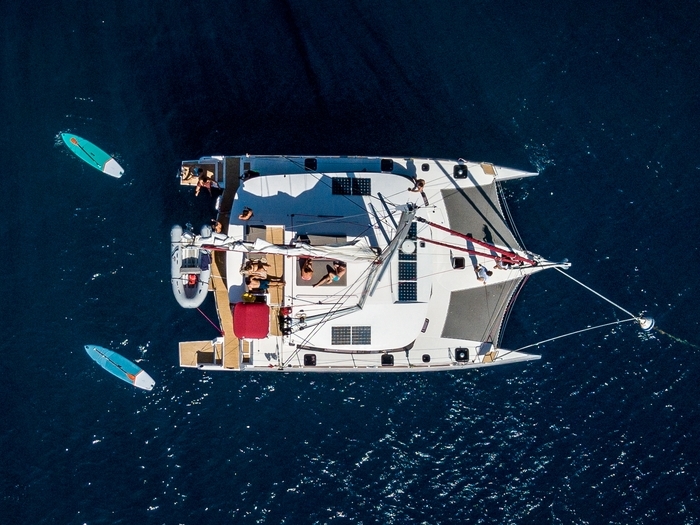
Read more: LEEN 72′: The Future of Hybrid Trimarans is Here .
After looking into the differences between catamarans and trimarans, we can conclude that they each offer distinct sailing experiences. Catamaran sails offer a sense of comfort and stability for extended cruising trips and luxurious living spaces, while trimarans are better on performance, safety – due to the increased width of their hulls – and speed when racing. Ultimately though, it all comes down to personal preference when it comes to choosing between a monohull, a catamaran or a trimaran. If you want to gain speed and enjoy the thrill of racing, then a trimaran may be your best option; however if you prefer comfort and more space while cruising, then a catamaran may be more suited for your needs. Whichever you ultimately decide to purchase, just make sure that it fits your specific circumstances and requirements.
If you’re looking to buy a trimaran, don’t miss this opportunity to learn about the latest models and their features. Get the inside scoop on what to look for in a trimaran and what you can expect to pay. Find out how to choose the right size and style to meet your needs and budget. And if you’re looking to sell your trimaran, don’t miss this chance to connect with a global audience of interested buyers. Showcase your boat’s unique features and benefits and reach a wider audience of potential buyers.
So don’t wait any longer! Take advantage of this opportunity to learn more about buying or selling trimarans. Whether you’re a seasoned sailor or just starting out, this is your chance to dive deeper into this exciting world of boat ownership. Click the link below to get started today!
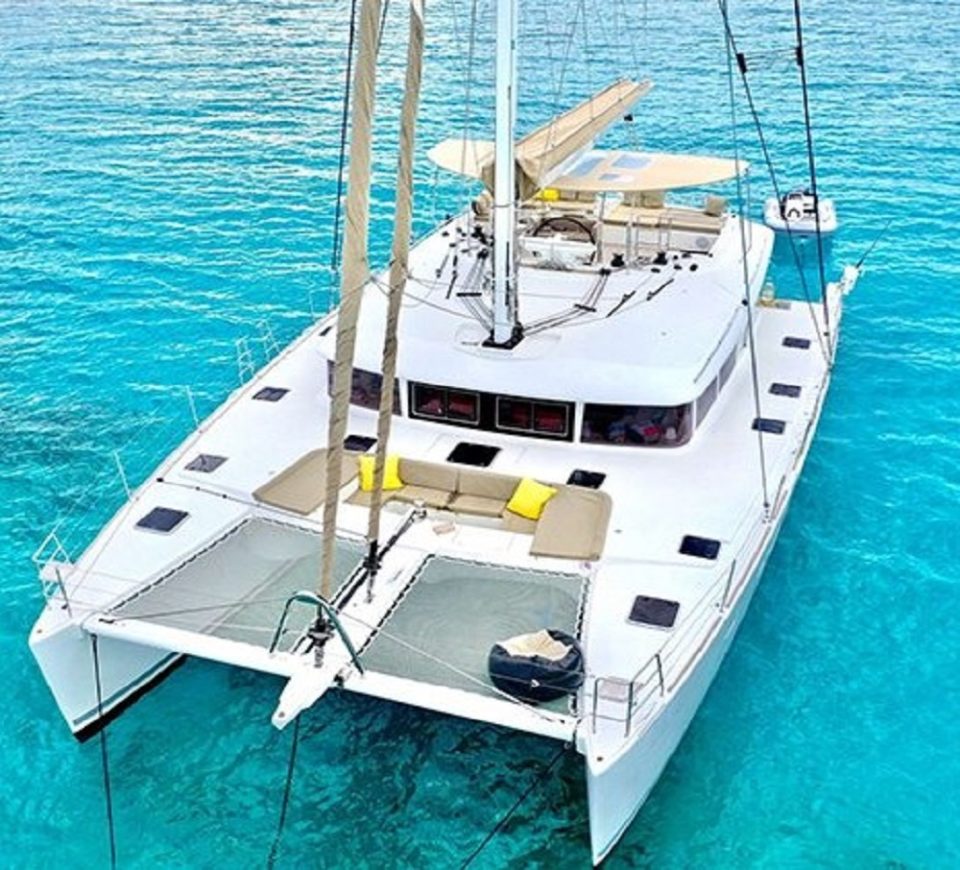
Whether you’re a fan of stability or speed, there’s one boat that can give you both – the trimaran vs catamaran. Catamarans provide plenty of living space and comfort in calm waters but struggle with choppy seas, while modern trimarans deliver excellent performance even on rough days yet still offer good room to relax onboard. But if vintage sailing is more your style opt for an older-style tri since it won’t be equipped with as much creature comforts!
Catamarans and trimarans are two types of watercraft that rapidly cut through the waves, but when it comes to speed one stands out above the rest. Trimarans have gained a reputation for being fast enough to take on any other vessel in a race – making them an excellent choice for anyone looking to shave precious seconds off their time!
When it comes to safety on the sea, two of the most popular vessels are Trimarans and Catamarans. Thanks to their side hulls, trimarans offer a much greater heeling angle compared with catamarans – meaning they’re less likely to capsize or sink in rough waters. However don’t let that put you off taking out a catamaran – while not as secure as its three-hulled cousin – these craft still provide plenty of stability for your seafaring adventure!
If you’re looking for an affordable seafaring vessel, the choice between a catamaran or trimaran can be daunting. With numerous factors that impact cost – from age and length to comfort levels and desirability – it’s often hard to tell which of these two sailing vessels will fit your budget best. But with some research, you’ll find just the right combination of affordability and quality suited perfectly to your needs!
RELATED ARTICLES MORE FROM AUTHOR
How to winterize your boat, sail the mediterranean onboard the custom line navetta 28 “yvonne”, how fast can a yacht go.
- Testimonials
- Privacy Policy

The global authority in superyachting
- NEWSLETTERS
- Yachts Home
- The Superyacht Directory
- Yacht Reports
- Brokerage News
- The largest yachts in the world
- The Register
- Yacht Advice
- Yacht Design
- 12m to 24m yachts
- Monaco Yacht Show
- Builder Directory
- Designer Directory
- Interior Design Directory
- Naval Architect Directory
- Yachts for sale home
- Motor yachts
- Sailing yachts
- Explorer yachts
- Classic yachts
- Sale Broker Directory
- Charter Home
- Yachts for Charter
- Charter Destinations
- Charter Broker Directory
- Destinations Home
- Mediterranean
- South Pacific
- Rest of the World
- Boat Life Home
- Owners' Experiences
- Conservation and Philanthropy
- Interiors Suppliers
- Owners' Club
- Captains' Club
- BOAT Showcase
- Boat Presents
- Events Home
- World Superyacht Awards
- Superyacht Design Festival
- Design and Innovation Awards
- Young Designer of the Year Award
- Artistry and Craft Awards
- Explorer Yachts Summit
- Ocean Talks
- The Ocean Awards
- BOAT Connect
- Between the bays
- Golf Invitational
- BOATPro Home
- Superyacht Insight
- Global Order Book
- Premium Content
- Product Features
- Testimonials
- Pricing Plan
- Tenders & Equipment

Bering Yachts introduces new 24m catamaran model BC80 with two configurations
Turkish shipyard Bering Yachts has announced a new 24-metre catamaran model known as BC80 at this year's Cannes Yachting Festival.
The yacht is the largest in its class at 24 metres and is joined by the 18.9-metre BC60 and the BC70, which measures 21.3 metres. Owners can choose between two layouts: the flybridge version and the solar-powered version.
The first has been billed as a "more classic yachting experience", featuring an expansive 82-square-metre flybridge and 1,000 square feet of solar panels which can generate over 20kW of energy on a sunny day. The yacht can then remain at anchor for extended periods without relying on generators.
Meanwhile, the solar-powered version is suited to "the environmentally conscious adventurer", with a massive solar panel array, high-capacity lithium-ion battery bank and a state-of-the-art "kick-saving" system. This system significantly reduces generator dependence and allows guests to enjoy silent cruising for up to 24 hours without running the generators.
The BC80's impressive interior volume is aided by an expansive 10.8-metre beam, giving guests the "ultimate three-decker experience" with a spacious main deck with 2.4 metres of headroom, a dedicated upper deck with flybridge option, and a comfortable lower deck. In terms of accommodation, owners can choose between four, five or six cabins with the option of a master suite on the main deck.
The standard layout features a galley positioned forward on the main deck, while all guest accommodations are located in the sponsons (hull extensions) for extra privacy and reduced noise.
Powered by a pair of Volvo Penta engines, the yacht will reach top speeds of 15 knots and a cruising speed of 10 knots.
This follows the news that the steel hull of its 39.5-metre B125 model had been transported from Istanbul to Antalya ahead of outfitting . Delivery is anticipated for September 2024.
Sign up to BOAT Briefing email
Latest news, brokerage headlines and yacht exclusives, every weekday
By signing up for BOAT newsletters, you agree to our Terms of Use and our Privacy Policy .
Similar yachts for sale
More stories, most popular, from our partners, sponsored listings.
More From Forbes
Azimut|benetti group shows strong growth at cannes yachting festival.
- Share to Facebook
- Share to Twitter
- Share to Linkedin
In attendance at the Cannes Yachting Festival last week, Azimut|Benetti announced robust revenue for ... [+] 2023-2024, an ambitious forecast ahead despite uncertain market conditions, and a new collaboration with Volvo Penta. Pictured here is the Azimut Fly 62, presented at Cannes, with reinvented forward cockpit and open stern.
Italian yachting group Azimut|Benetti broadcast rather pleasant news at a press conference at the opening of the Cannes Yachting Festival , September 10, 2024. Noting a strong upward trend in the Group's fiscal status, the team announced revenues were up from $935 million (€840 million) in 2020-21 to $1.45 billion (€1.3 billion) in 2023-24, signaling a robust 55% growth.
Azimut|Benetti By The Numbers
The financial year to August 31, 2024 provided a 30 percent increase in profitability, year-on-year, citing business growth and increased operating efficiency. Additionally, new orders as of January 1, 2024 ensure continued success totalling $2.9 billion (€2.6 billion). That backlog distribution comes from a broad mix of 40 percent European, 37 percent from the Americas, and 23 percent from MEA APAC customers. Azimut|Benetti expects double digit growth in 2024-25, aiming at a new revenue target of $1.7 billion (€1.5 billion).
To continue the trend, the Group has a €160 million investment plan supporting the company's strategic priorities. Additionally, a further $48.1 (€43.2 million) is earmarked for R & D and new product development, and $15.5 million (€13.9 million) to go toward digitalization and virtual reality used in prototype, design, and communication with owners throughout the purchase and build of their yachts.
Some might think these numbers optimistic, but from Azimut|Benetti's point of view, the outlook is not only realistic, but reassuring.
"After a period of unprecedented growth, we are now experiencing a physiological contraction of the market, which the Group can manage from a position of strength thanks to the significant order backlog," states Marco Valle, Azimut|Benetti Group CEO. He continued, "In this scenario, the Group's strategies have made and will make the difference: innovative yachts and the correct positioning of the Azimut and Benetti brands, a broad-based international presence and ongoing production evolution."
Azimut's Seadeck 7 was on display at last week's Cannes Yachting Festival, September 10-15, marking ... [+] a first for the collaboration between Volvo Penta and Azimut.
Best High-Yield Savings Accounts Of 2024
Best 5% interest savings accounts of 2024, another announcement at cannes.
Azimut|Benetti and Volvo Penta unveiled the world's first yacht boasting a combination of Volvo Penta with hybrid power. The new Azimut Seadeck 7 piloted Volvo Penta's helm-to-propeller hybrid-electric package for the first collaboration with Azimut.
The Seadeck 7, using hybrid-electric technology, can cruise in pure electric mode up to 11 knots and can stay at anchor with zero emissions for up to 12 hours. It marks a unique milestone as the first time a yacht will use diesel engines, electric motors, and batteries paired with the efficiency of Volvo Penta IPS drives , operating in hybrid mode without use of a generator.
"When it comes to reducing CO2 emissions, our approach is aimed at generating tangible results now, also by developing new solutions that we are already implementing at a prototype stage," notes Giovanna Vitelli, Chair of Azimut|Benetti Group.
Vitelli further explains that, "The Volvo Penta hybrid-electric package installed on the Seadeck 7 has a mode of use similar to that of cars, meaning that it shifts from electric to diesel based on speed." That ensures the yacht is easy to use, consumes less fuel, emits less CO2, and improves the on board experience for guests. "Everything is in place to change the rules of the game,"Vitelli concludes.
Additional features of the Seadeck 7, displayed at the Cannes Yachting Festival from September 10-15, include joystick docking, joystick steering, dynamic positioning system, and a glass cockpit system with hybrid-electric driver interface view displaying important data.
More News At The Upcoming Monaco Yacht Show
Ahead of the Monaco Yacht Show , Azimut|Benetti will again take the spotlight for a media conference at Hôtel Hermitage in Monte-Carlo on September 26, 2024. Entitled "The Shape of the Future," the presentation will be dedicated to innovation, design, and advanced technology.
Stand Azimut is scheduled to be located in Port Hercule along the Quai des États-Unis at QE7, featuring the Magellano 30-meter, the Grande 36-meter, and the Grande Trideck, docked at E01, E03, and E04.

- Editorial Standards
- Reprints & Permissions
Join The Conversation
One Community. Many Voices. Create a free account to share your thoughts.
Forbes Community Guidelines
Our community is about connecting people through open and thoughtful conversations. We want our readers to share their views and exchange ideas and facts in a safe space.
In order to do so, please follow the posting rules in our site's Terms of Service. We've summarized some of those key rules below. Simply put, keep it civil.
Your post will be rejected if we notice that it seems to contain:
- False or intentionally out-of-context or misleading information
- Insults, profanity, incoherent, obscene or inflammatory language or threats of any kind
- Attacks on the identity of other commenters or the article's author
- Content that otherwise violates our site's terms.
User accounts will be blocked if we notice or believe that users are engaged in:
- Continuous attempts to re-post comments that have been previously moderated/rejected
- Racist, sexist, homophobic or other discriminatory comments
- Attempts or tactics that put the site security at risk
- Actions that otherwise violate our site's terms.
So, how can you be a power user?
- Stay on topic and share your insights
- Feel free to be clear and thoughtful to get your point across
- ‘Like’ or ‘Dislike’ to show your point of view.
- Protect your community.
- Use the report tool to alert us when someone breaks the rules.
Thanks for reading our community guidelines. Please read the full list of posting rules found in our site's Terms of Service.

IMAGES
VIDEO
COMMENTS
What is the Difference Between a Yacht vs Catamaran? A yacht refers to any vessel over 79ft so a catamaran greater than 79ft can also be a yacht. Catamaran yachts are known for their elegant aesthetics, spacious interiors, and extravagant amenities such as multiple decks, lavish cabins, and state-of-the-art entertainment systems. Catamarans are ...
When it comes to maneuverability and sailing dynamics, there are some key distinctions between catamarans and yachts: Speed - Catamarans are lighter and have reduced drag, making them significantly faster than yachts. Top speeds can reach up to 25 knots. Stability - With their twin hulls, catamarans offer unmatched stability and minimal ...
What are the Differences Between a Yacht and a Catamaran? Understanding the differences between a yacht and a catamaran is crucial for anyone considering a purchase or charter in areas like Florida or Cancun. Yachts encompass various types, including motor yachts and sailing yachts, while catamarans are defined by their dual-hull design.
The primary differences between a yacht and a catamaran for sailing are evident in their design, performance characteristics, and overall sailing experience. Yachts, especially in the monohull configuration (which means a single hull design), typically employ traditional sailing techniques and feature a narrower profile. This can be ...
Unlike yachts, catamarans generally have a minimum of two engines. These motors enhance the level of maneuverability of the vessel. In other words, catamarans are easier to pilot or maneuver than yachts of the same length. Furthermore, the presence of a second engine on a catamaran makes it noticeably more potent than a yacht.
Explore yacht and catamaran options, safety tips, and buying advice in this comprehensive guide. +49 211 54 69 22 23. FormResult. Yacht Charter; ... In this comprehensive guide, we will explore the differences between yachts and catamarans when it comes to sailing in heavy weather. Whether you're a seasoned sailor or a novice, understanding the ...
Catamarans don't coast well primarily because they don't have a deep keel to track. Relying on coasting to a dock at a shallow angle and then going into reverse and using prop walk to cozy up the stern won't work. It is better to come in at a sharper angle and then pivot the boat into position with the engines.
Yachts, being the age-old favorites, come equipped with tried and tested safety gear. Their design ensures that equipment is within arm's reach, crucial during emergencies. Making an Informed Choice: The Final Verdict on Safety. In the debate between catamarans and yachts, one might wonder if there's a clear winner in terms of safety.
Shape / Number of hulls. The main difference is the shape of the boat: a yacht or traditional sailing boat has one hull (the bottom of the boat) which sits in the water, but a catamaran is a 'multi-hull' so has two hulls or points of contact with the sea, with a platform across the top which joins the two hulls together into one boat shape.
A catamaran is much better than a monohull in many ways. Catamarans are more stable, faster, and spacious. They also offer safer anchorage and are easy to control. Monohulls are more maneuverable, have lower costs, and better when sailing upwind.
The difference in available space is as clear as day. It is because of the difference in the hull shape. The catamaran has ample space in areas like the salon, galley, and flybridge. Even its cabins are more comfortable, and you'd be able to sit upright. Also, unlike the motor yacht, several cabins in a catamaran are ensuite.
Catamarans are known for their unique design, which features two parallel hulls connected by a deck. This design provides several advantages over traditional monohull boats, such as stability and speed. With their wide beam, catamarans have a reduced risk of capsizing and can access shallow waters due to their shallow drafts 1.
When sailing downwind, catamarans usually achieve greater speed than sailboats. Sailboats, on the other hand, perform better when sailing upwind. During turns, sailboats are better manoeuvrable and respond to a helm better, while catamarans lose the necessary impulse for a prompt turn faster. Unlike a sailboat, a catamaran is practically ...
Catamaran vs. Yacht: Cost Differences. A new, high-quality catamaran larger than 40 feet can run about half a million in cost. Pre-owned catamarans can run as low as $35,000, while larger, new catamarans can exceed $5 million. Catamarans will also cost more because of the need for two engines and two rudders.
What is the Difference Between a Yacht and a Boat? A yacht and a boat can be defined by their size, with boats typically measuring up to 78 feet, and yachts starting from 79 feet and above. ... Catamaran vs Yacht. Catamarans and yachts also have their differences. A catamaran can be a type of sailing vessel and, when larger in size, it becomes ...
What Is Better to Charter a Catamaran vs Yacht? Those new to yacht charter and catamaran charter will often ask, what is Better to charter - a Catamaran or Yacht?To assess the catamaran vs yacht question, we need to understand the main differences. A catamaran is, strictly speaking, a yacht with two hulls and a yacht in this context and a sailing vessel with one hull, otherwise known as a ...
Yachts are broken down into groups based on size, and day sailing yachts are the smallest, followed by weekender yachts, cruising yachts, and luxury yachts. Some people refer to catamarans as two-hull yachts, and three-hulled yachts are also being developed. Sailing yachts are normally between six meters and 30 meters (19.69 to 98.43 feet) in ...
As noted above, catamarans don't really heel over. This makes the entire sailing experience different; the motion of the boat is different, you have to trim the sails differently, and pay attention to other factors that you might not be used to. In light wind and upwind sailing conditions, it can be harder to make headway.
Jul 30, 2018. Original: Aug 17, 2015. Two sailboat experts argue monohull vs. catamaran. Contributed by Denison Yacht Sales. The great debate over which is better—one or two hulls—boils down to several factors, each with distinct advantages and disadvantages. The verdict usually defaults to personal preference and intended use of the vessel ...
"Class D" Boats are vessels that can safely handle winds of 13-15 MPH and waves between 1-2 feet or less in sheltered waterways.Note: any vessel below Class B is referred to as a boat, hence the difference. Waters of Operation And Accommodations. Yachts, from their inception, have been constructed to endure lengthy voyages on open water.
Upwind sailing performance: While catamarans have the edge at straight-line speed, monohulls sail closer to the wind. When you're racing or you have to sail upwind to get to the next island, this can get you there faster. Sailing feel and responsiveness: The "feel" of sailing a monohull is much better.With a single hull, you'll feel wind pressure and trim adjustments immediately for a ...
Comprehensive guide to catamaran sailing for beginners: understanding the differences between sailing a catamaran and a sailboat, what to expect, pros and cons and choosing the right catamaran. +49 211 54 69 22 23. FormResult. ... Sailors have differing preferences, with some sticking to single-hulled boats and others preferring catamarans. In ...
Catamaran sails offer a sense of comfort and stability for extended cruising trips and luxurious living spaces, while trimarans are better on performance, safety - due to the increased width of their hulls - and speed when racing. Ultimately though, it all comes down to personal preference when it comes to choosing between a monohull, a ...
Turkish shipyard Bering Yachts has announced a new 24-metre catamaran model known as BC80 at this year's Cannes Yachting Festival. The yacht is the largest in its class at 24 metres and is joined by the 18.9-metre BC60 and the BC70, which measures 21.3 metres. Owners can choose between two layouts: the flybridge version and the solar-powered ...
He continued, "In this scenario, the Group's strategies have made and will make the difference: innovative yachts and the correct positioning of the Azimut and Benetti brands, a broad-based ...
The Teralani catamaran, part of the popular Teralani Sunset Sail tour, ran aground in shallow waters around 7 p.m. A distress call prompted a swift response from the Maui Fire Department (MFD ...